The Talk Sea Fishing guide on whiting fishing, looking at all of the techniques to catch whiting from shore and boat with bait and lures.
Often accused as being a less desirable species, along with flounder, whiting is often one of the first fish an angler catches, and in that, it has a special place in the heart of many sea anglers.
It is a willing feeder and gets the rod tips rattling when other species prove elusive. Even the most experienced and diverse sea angler, most winters, will have one or two nights on a "whiting bash". A night on the whiting can also restore lost confidence in those of us that might have suffered a tough time during recent fishing trips.
Although whiting is the common name, it can be called merling in some areas. Until the late 1900s whiting were classed as cheap and a poor man's food and often used for cheap pet food.
In current times the fortunes of whiting have improved with it being more highly valued as a food fish due to its delicate flesh and slightly sweet flavour that requires minimal cooking time.
Without experience, the whiting is most likely to be confused with its near cousin the cod. But there are simple things to look for to identify one from the other.
The whiting's head is narrower and more pointed than the cod, which is generally heavier built in the head and body. All cod have a chin barbel or feeler on the lower jaw, but this is only small and evident in juvenile whiting, adults lose this. The upper jaw slightly protrudes the lower jaw. The whiting has three dorsal fins like the cod, and these are closely joined at their bases. It also sports two anal fins, the first being the longer, which originates beneath the middle of the first dorsal. On the cod, the first anal fin begins either inline or just behind the second dorsal fin's forward edge.
The whiting's colouration in shallower water and over sand is a light brown or fawn with silvery-white sides. There is also a conspicuous dark spot positioned at the upper front edge of the pectoral fin and just rear of the gill-plate. The whiting tends to have a darker brown to greeny-blue back in deeper water and can be more silvery on the sides.
The majority of whiting are sub 2lbs, but they can achieve lengths of 30-inches (76cms) and weights approaching 10lbs, though this is now unlikely due to commercial overfishing.
The spawning period is extended between January and July, with fish in the southern side of their habitat more likely to breed in the colder months and early spring. The smaller juvenile fish up to 1.25-inches in length or so often form small shoals under live jellyfish using the tentacles for protection.
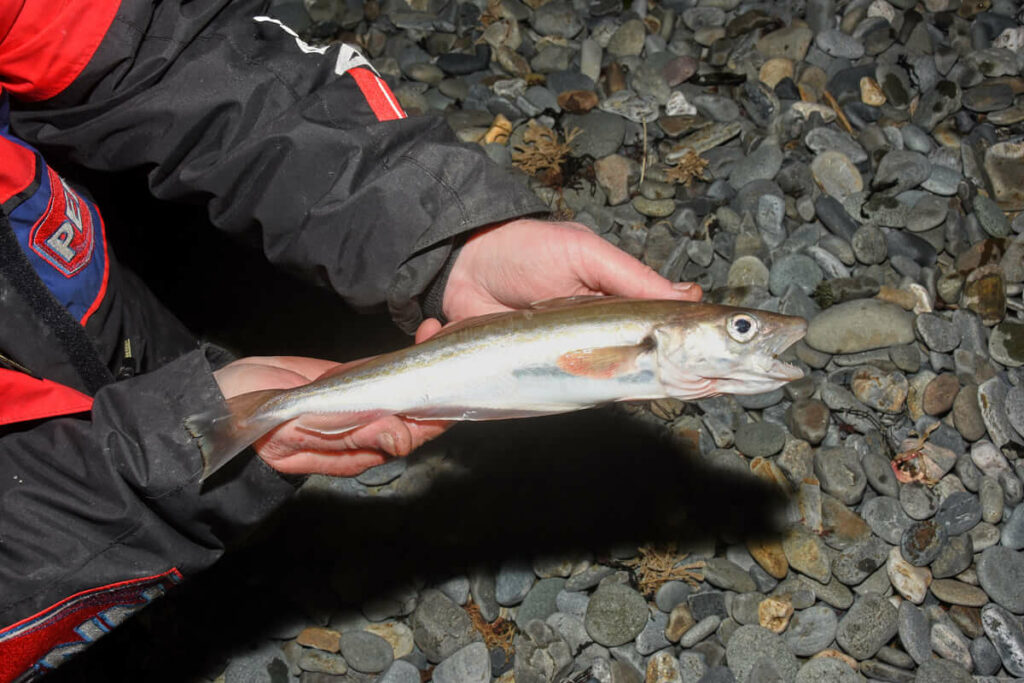
Whiting have an extensive distribution range being found throughout the northern half of the Mediterranean, north along the European coast, throughout Norway and just into Russian territory. They are also found in a thin extended line from The Faroes and all around Iceland.
They are common throughout the UK with large concentrations found in the English Channel where some of the biggest whiting are caught, also inside the North Sea, the Irish Sea and the west of Scotland. Again they are common all around Ireland with some bigger fish likely off the southwest corner of Ireland, also off Donegal and Northern Ireland.
Juvenile whiting eats mostly crustaceans such as small shrimps. The adults have serious pin-like teeth giving the game away that they are true full-on predators eating typically, small whiting, poor cod, pouting, small herring, small flatfish and sandeels.
They are also happy to scavenge on the seabed and will also take shellfish and molluscs if they come across them.
When tight inshore their diet includes all manner of worms including lug and ragworm, mussel, cockle, sand clam, and any small fish they come across.
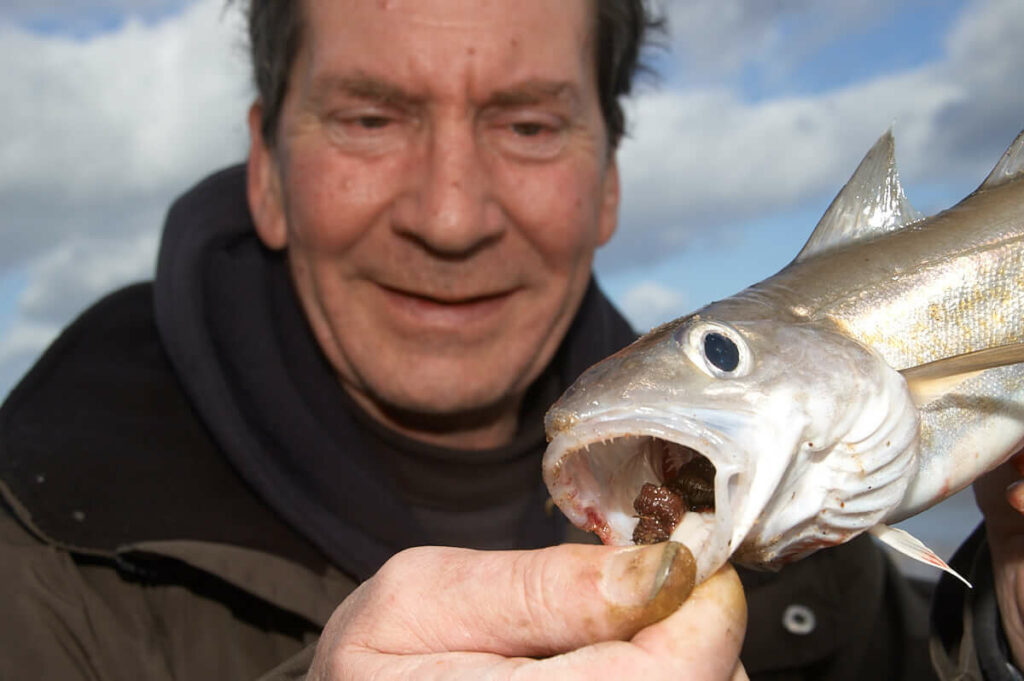
Smaller whiting can be caught inshore pretty much all the year-round. However, the traditional whiting season is from mid-September when the vanguard of the main whiting shoals first appear. Their numbers grow quickly and by early October, and especially if the first frosts are on the land, their numbers escalate quickly. The peak month is November to mid-December when they gradually start to thin out, and by the end of January, the best is over.
That said, late January and throughout February there can be a run of bigger fish between 1 and 2lbs, sometimes bigger. This applies both on the shallow surf beaches and fishing deeper water from man-made structures or rock ledges.
Whiting have specific habits when it comes to the type of ground they prefer, and we need to look at this in detail to get the best from the fishing.
Sandy surf beaches
On sandy surf beaches, they will come into relatively shallow water and can often be found in the surf from 30-yards out if the weather is calm with a gentle surf. They do not like rough conditions and big surfs, so expect the fish to be further out in these conditions.
On shallow beaches, there is usually a defined low water bank or definite lift in the ground feature. This is where the typical wave action hits the shore at the mean low water level. The whiting stays out beyond this until the water depth on the main beach increases, then they will move in, in numbers.
Around the mid-tide time they will feature across a wide area of the beach, typically being concentrated in areas where there are depressions in the sand, or better still, deeper gullies and gutters that run parallel along the beach. These gutters collect and hold food and are real hotspots.
A good tip on a shallow surf beach with a shingle shoreline is to look for areas where large amounts of waterborne debris collect at the high water mark. This indicates where a tidal current comes ashore, and fishing out into this can be a great spot to try.
Other good spots to try are close to rocks that meet sand, especially areas where cliffs are at the end of beaches. These can produce the bigger whiting which are looking for smaller fish that try to use the rocks as cover.
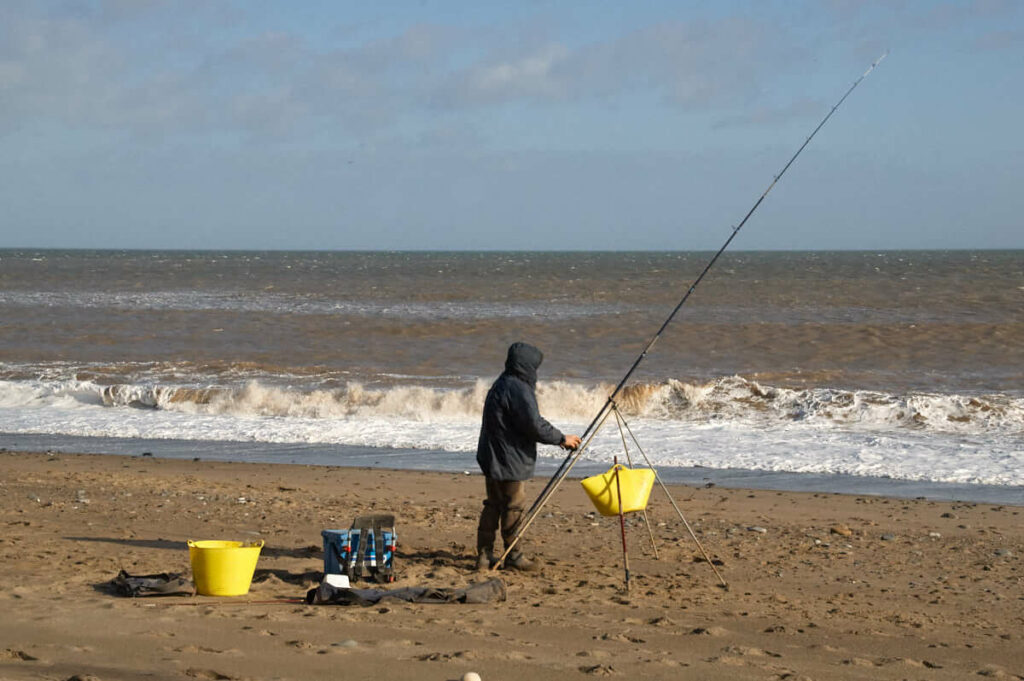
Steep-to beaches
These tend to be easier to fish as the shoals tend to be widespread over the whole area. If sea currents create any known depressions or scooped out areas, fish them. Other good spots are where a point of shingle or sand juts out into deeper water. Whiting like to sit just inside the edge of the current created as the tide works around the point and their numbers will be heavier here.
And don't forget those wash-up areas on the shingle where the current hits the shore. Again this is a top spot to try.
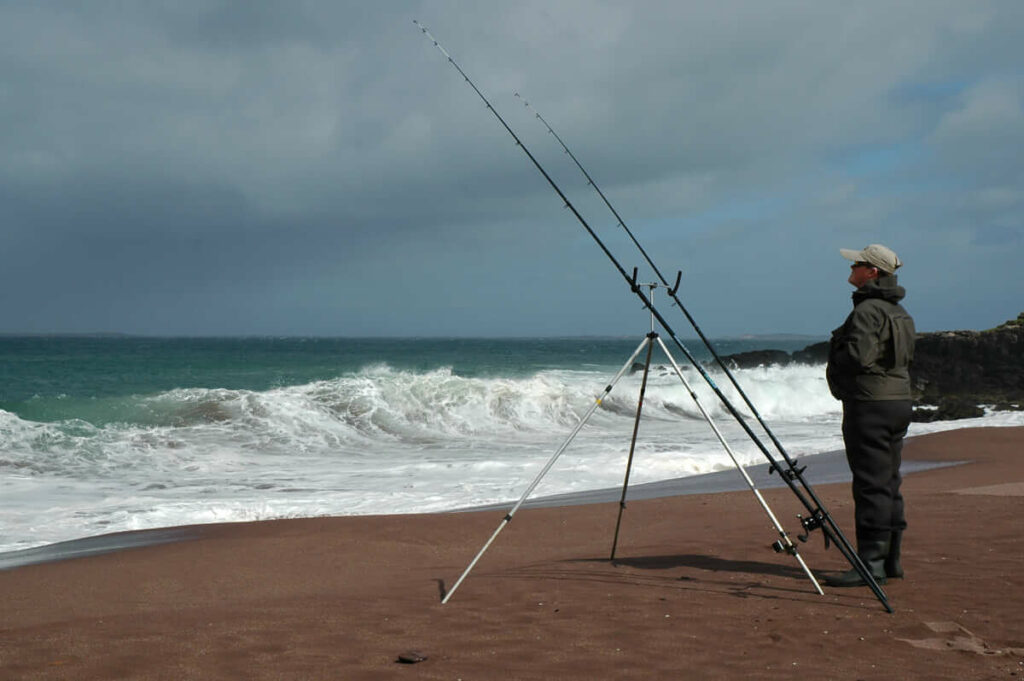
Man-made structures
Piers tend to see a gutter directly under the pier structure that is usually exposed stone, boulders or mussel beds. You need to cast a fair way away from the pier out into deep water and over the cleaner ground to find the whiting usually. If you can identify any areas of rising sandbanks or ridges, these can be excellent.
It's much the same from breakwaters. These tend to give on to deeper water, and casting away from the structure out onto clean ground is bound to see fish caught. However, don't neglect the ground immediately out from the structure but close into the rock foundations, which is often the place the bigger whiting are caught.
If the structure gives casting access to a deeper channel used by boats entering a harbour, this will be the hotspot throughout the flooding tide and is also the exit route for whiting using it to return seaward as the tide ebbs out. The extra depth and tide flow will concentrate the shoals of whiting here.
Also try to locate, by casting, areas where mussel beds appear due to the tide running round or through man-made structure displacing sand and fish to the side of these. Also areas of shingle where sand meets it. Any break up in the natural seabed feature can and will attract whiting.
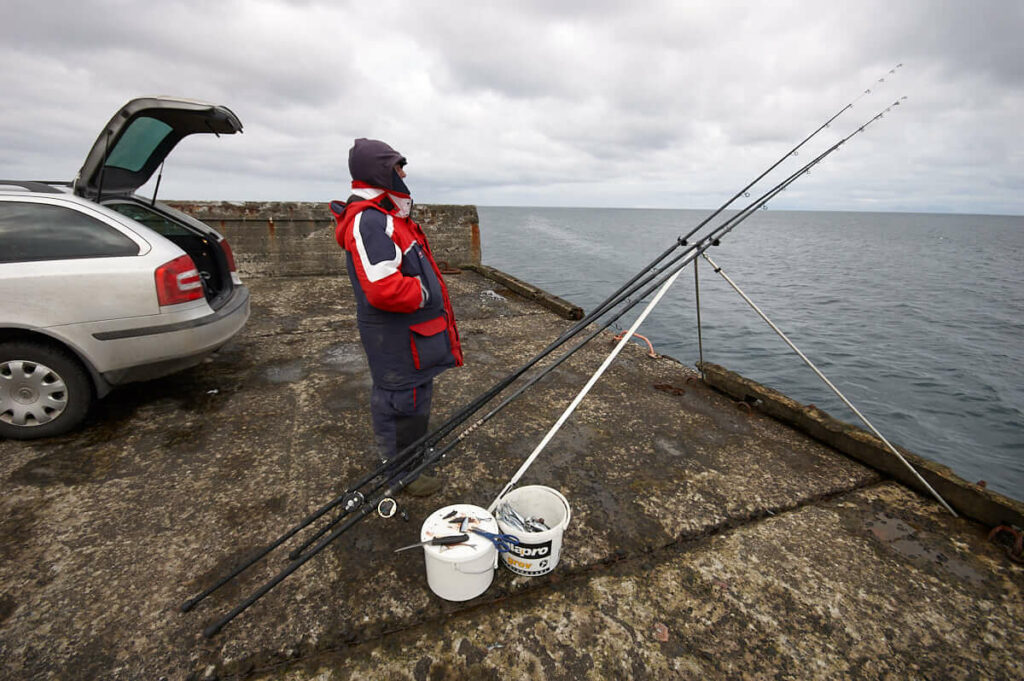
Rock ledges
On the open coast rock ledges, it's the more open bays that see the best of the whiting fishing. They tend to sit out in the deeper water, then as the flood tide starts to move in, they follow and fill the bays covering every inch of clean ground.
Other good spots are where sandy patches run in between rougher ground. These are often good areas to pick up bigger than average whiting, especially in the post-Christmas period. Probably the best tip is to try to locate areas where a tide run is deflected by a small headland or reef and fish any clean ground close to this.
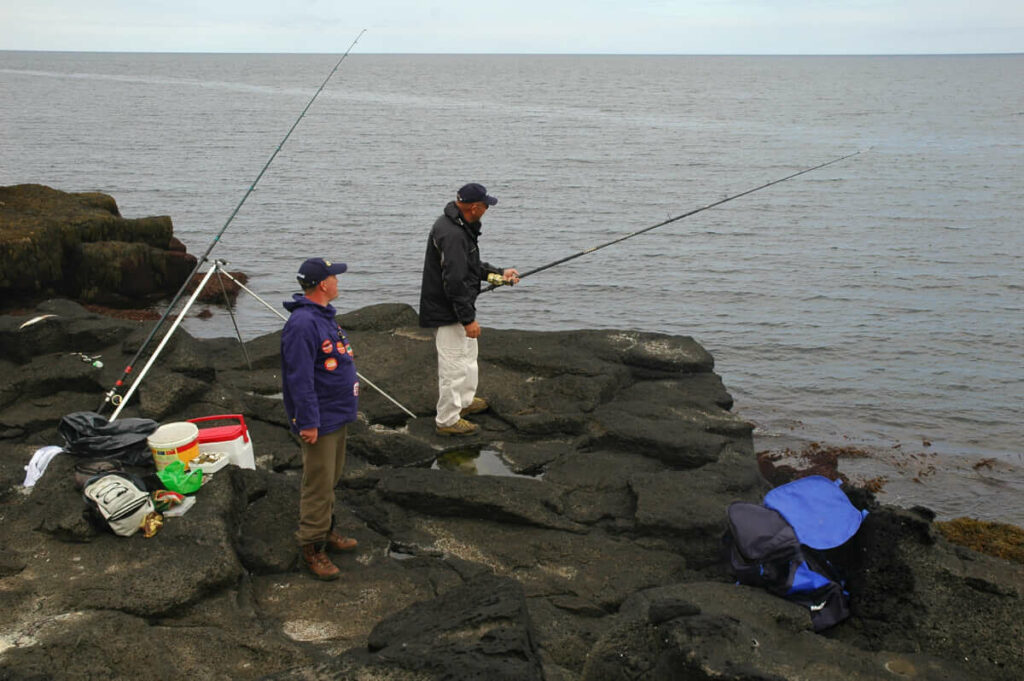
In deeper water, and especially off a man-made structure, you'll catch whiting whatever the tide's size, but generally the better catches will be taken on the bigger tides. As is so often the case, it's the tides rising towards the highest springs that produce the best fishing. When the tides are falling back to neaps, then the whiting's overall numbers will be lower.
It's much the same from the steep-to beaches with most tides producing fish, but again, it will be those climbing tides that produce the best fishing. Though whiting will show up on the neaps on surf beaches, it's the bigger tides with their faster-moving water and the overall greater depth towards high water that will bring the fish in.
On shallower surf beaches at low water, they tend to be well out, possibly on the fringe of your maximum casting range, but good casters can still enjoy fair catches at this time. As soon as the tide starts to flood the shoals will begin to move closer and closer to shore literally following the tide in up the beach and you'll catch at medium range consistently through the middle hours of the tide. The hour before high water they will be from 30-yards to 70-yards out and really concentrated in numbers. However, as soon as the ebb tide begins, they will quickly filter out into deeper water, and again it's the bigger casters that usually do best at this time.
Generally speaking, you'll find on all venues that the whiting bites will be slow until the tide starts to flow more strongly with the best period the middle three hours of the flooding tide. The ebb bites will be at range and fewer in number, but again the ebb's middle hours will prove best.
Their preference is for calm weather periods with flat seas and a light surf on both shallower surf, deeper steep-to beaches and when fishing from man-made structures. The rougher the seas, the further the whiting push out. After periods of rough weather, it also takes a few tides for the sea to settle and the whiting to return in numbers.
Ideal conditions are big tides with both low and high water in the dark during prolonged periods of calm seas. Frosty nights are perfect for shore whiting. The TSF team look to fish tides that begin to flood in full darkness with high water in darkness and that light onshore or even a gentle offshore wind for the very best results.
Whether fishing from surf beaches, deeper beaches, man-made structures or off the rock ledges, whiting fishing generally dictates you will need to cast a fair way for consistent results. Also to combat faster-flowing tides and deep water, plus lift fish from the sea if you're on a pier or breakwater.
All these scenarios dictate using a typical UK beachcaster rated 4-6oz between 12ft and 13ft in length. A 6500 type reel loaded with 15 to 18lb mono line and a 60lb shock leader is the right choice on the shallower beaches. If you're fishing from deeper steep-to beaches, man-made structure and rock ledges, then a reel with more gear power is needed, and the Penn 525 series fits the bill perfectly, or reels from other manufacturers built with similar tough gears. Load this reel with 18 to 22lb mono and that ever-important 60lb shock leader.
If you prefer fixed spool reels, then the rod to go for is a continental style 14ft matched to a 7500 sized reel with a Long Cast type spool. These should be loaded with 30lb braid and either a 60lb tapered shock leader, or an 80lb braid leader knotted to the main braid using two back to back Grinner knots.
In calmer seas some anglers use a 2-4oz bass rod and a small 5500 or 6500 sized multiplier loaded with 15lb line and 30lb mono shock leader, alternatively a 5000 sized fixed spool reel and 30lb braid with no leader. This lighter approach using leads up to 3ozs is perfect for medium range fishing off the beaches, even when fishing three hook rigs and taking whiting three at a time.
Sometimes a lighter spinning rod about 9 to 10ft with a 4000 fixed spool, 20lb braid and light 1oz lead with a single flowing trace is an option in calm weather on the shallow beaches targeting just one fish at a time. This very light tackle gives that bit more sport, and sizable whiting will let you know it's there on this gear.
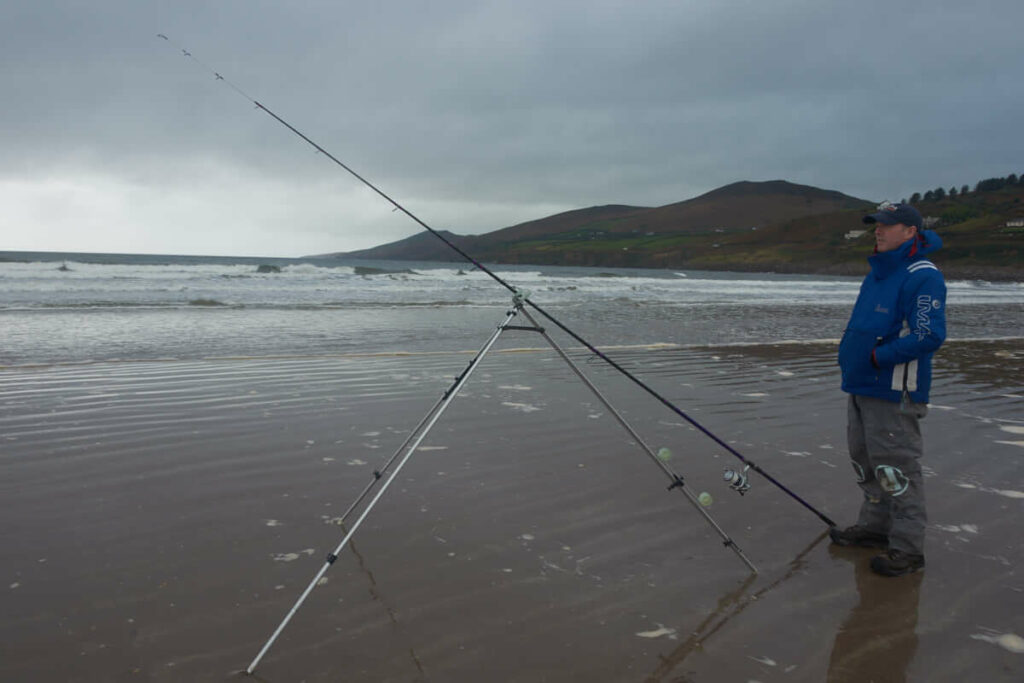
Many rigs will take whiting, but specific ones for specific situations will give the best results.
3-Hook flapper
This is the best rig for general beach fishing, either shallow surf beaches or deeper steep-to beaches. It's easy to build, too!
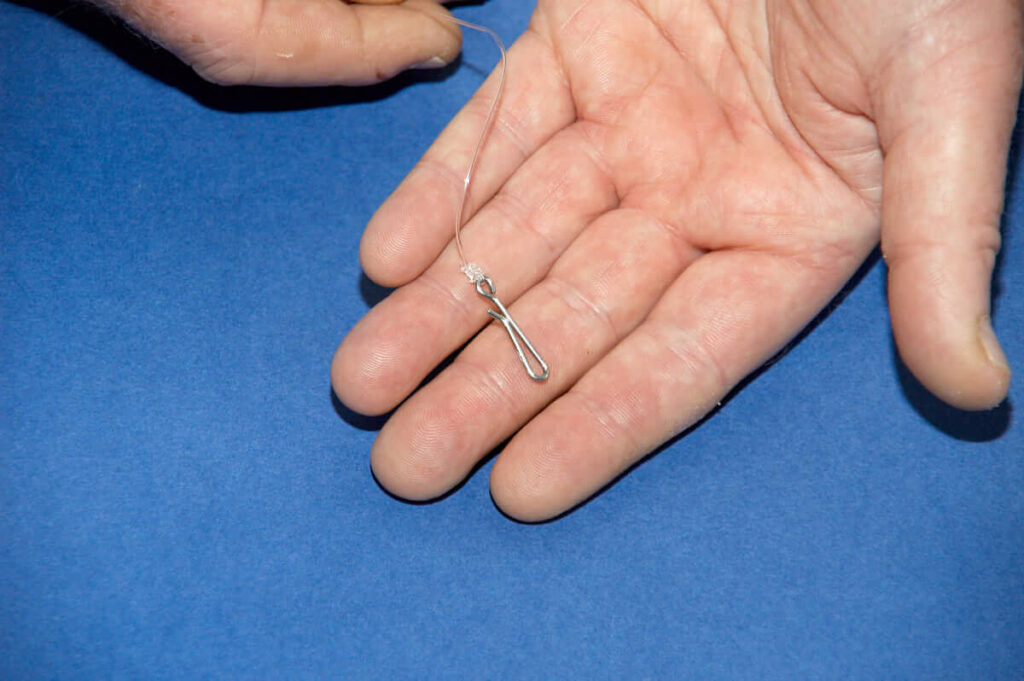
1. Start with about 64-inches of 60lb clear mono. Tie on a Gemini lead link at one end.
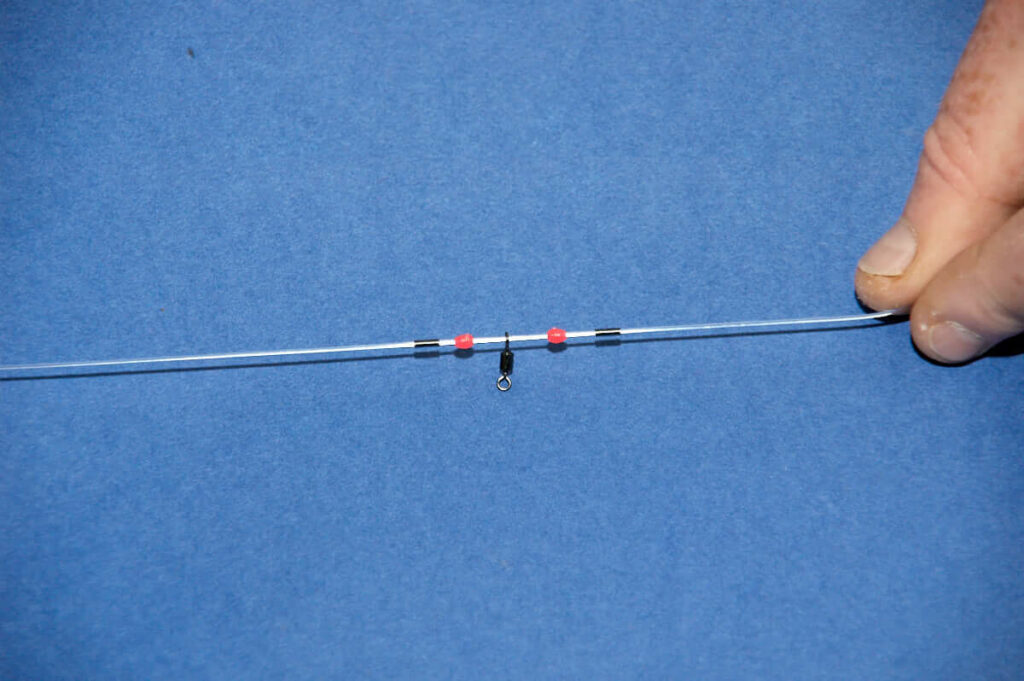
2. Slide on a rig crimp, a 3mm oval rig bead, a size 10 swivel, another rig bead and a crimp. Repeat this sequence to give you three full individual sets of crimps, beads and swivels. Leave these loose for now.
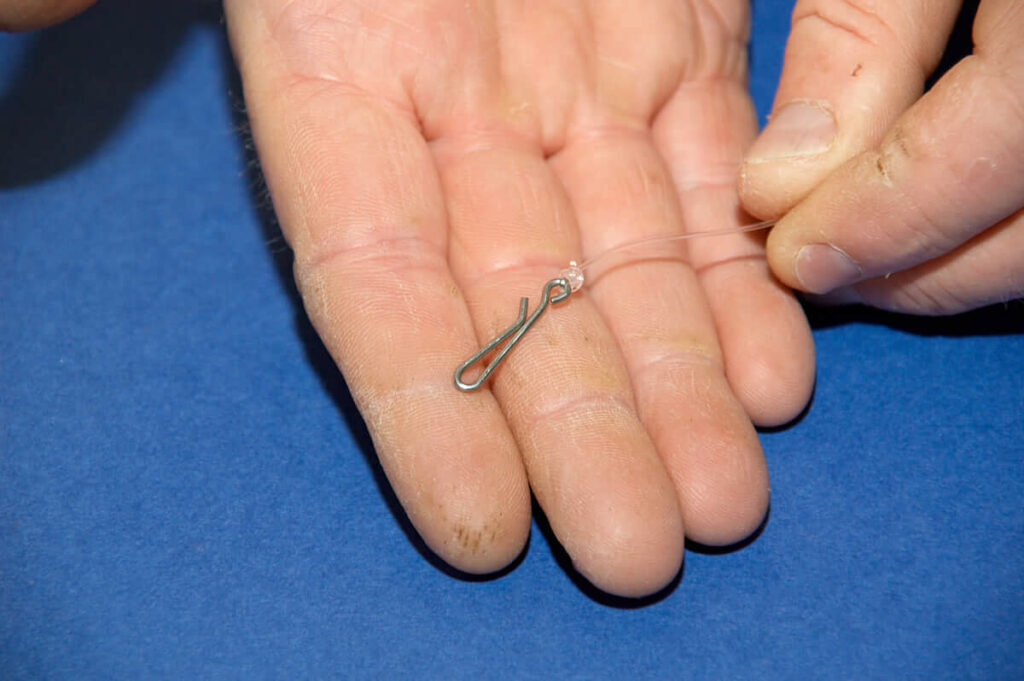
3. Complete the rig by tying on an inverted (upside down) Gemini lead link to the tag end of the rig body line.
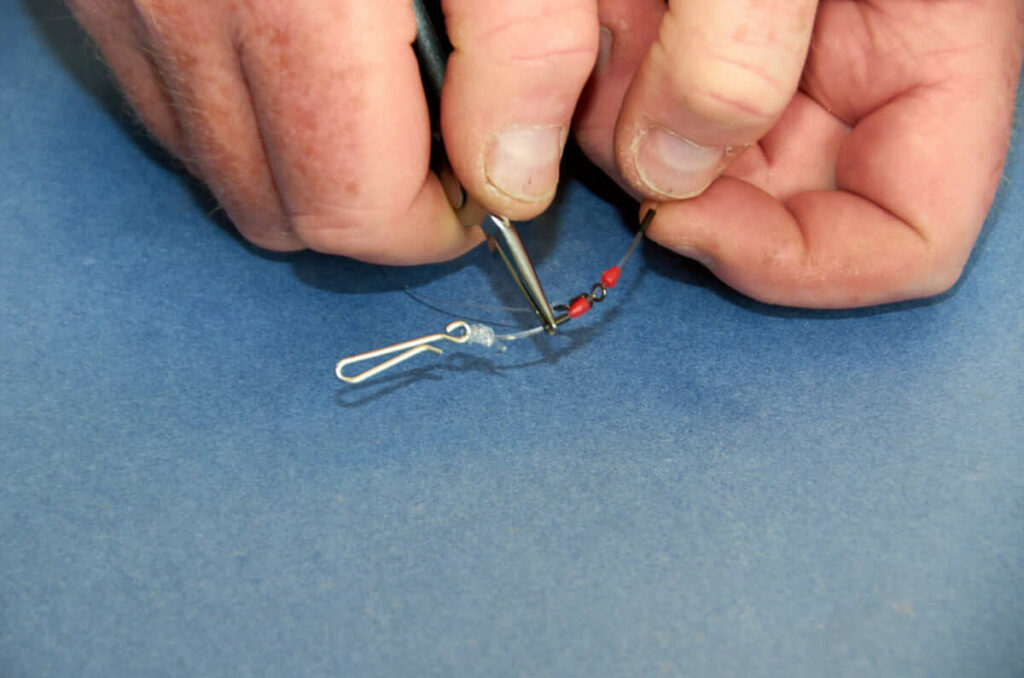
4. The first hook trace swivel needs to be placed just one inch below the top Gemini lead link. The middle swivel should be positioned exactly 17-inches below the top swivel, and the third again 17-inches down from the middle hook trace swivel.
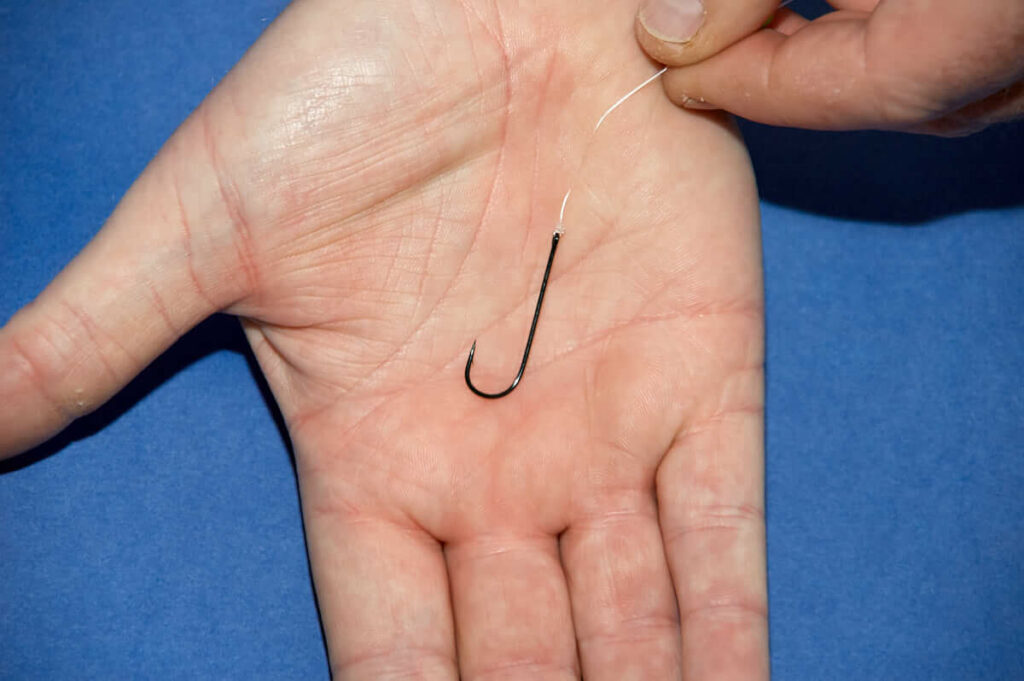
5. The top hook trace needs to be the longest at about 15-inches, the second hook trace measures 13-inches, and the bottom hook trace is the shortest at just 10-inches. All hook traces are made from 20 mono or fluorocarbon and are finished with a size 2 Kamasan B940 hook for general species.
A major feature with this particular rig is that the three hook snoods are positioned to present the baits differently to target specific species. If you fish the rig to a tight line direct to the rod tip, the lowest hook will be on the seabed, or at worst in a lively shallow surf, lifting up and down naturally bouncing on the ground.
A common mistake is to make all three hook lengths the same length. The hook snoods' lengths on this reversible rig are deliberately tied as different lengths. When fishing to a fairly tight line at close to medium range, the rig's full length will not sit flat on the seabed. Only the bottom hook is fishing hard on the bottom and consistently catching fish. If tied on too short a snood, the other two hooks are suspended up in the water column and less likely to catch.
This rig is tied using a longer top and middle snood. This helps keep the baits tighter to and in contact with the seabed and inside the main fish-feeding zone, even when the rig body length is lifted by passing surf tables, without the need to fish a slightly slack line between the rod tip and lead weight. The longer snoods also allow the baits to move more naturally.
You can also deliberately fish to a very tight line, and this will help lift the top two baits off the seabed periodically when a surf table passes and can sometimes better target the more active whiting.
By having a clip link at both ends of the rig body, you can literally reverse this rig around. If all the fish are falling to the bottom hook with the lower hook trace positioned well up above the lead, reverse the rig so that what was the top hook, now fishes tight behind the lead. The middle hook is now positioned where the first one was before you reversed the rig around. This puts two hooks in the feeding zone, giving you the chance to double your catches.
Always fish this rig with a released wired lead. The baits need to be anchored for the whiting to easily follow the baits scent trail, plus when they take the bait, they come up hard against the lead, creating a self-hooking effect.
1 Up/1 Down clipped rig
This 1 Up/1 Down rig is the best for fishing from man-made structures and rock ledges but is also employed on the beaches when whiting are at long range. The bottom hook trace fishes hard on the seabed where the bulk of the whiting are feeding, but the top hook length suspends slightly up in the water and will still be taken. When fishing from man-made structure, after casting, you can also fish this rig to a slightly slack-line, just releasing 2 or 3ft of line to create a downward bow. This drops the top bait tighter to the seabed and though you will see the bite on the rod tip, a better way is to watch the bow in the line to lift as this is the initial indication of a bite.
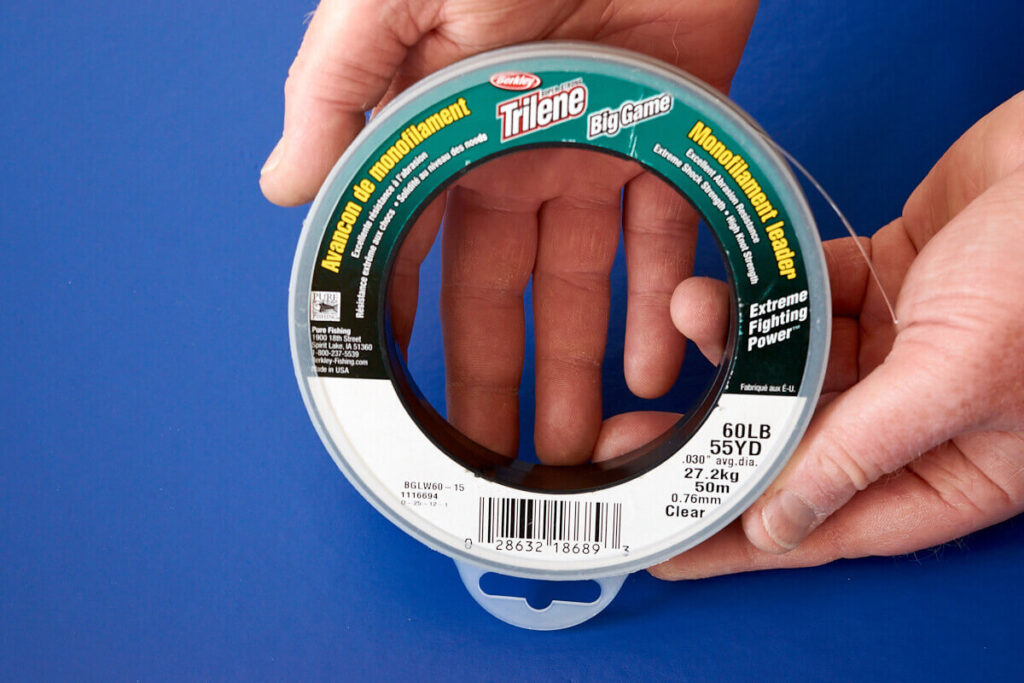
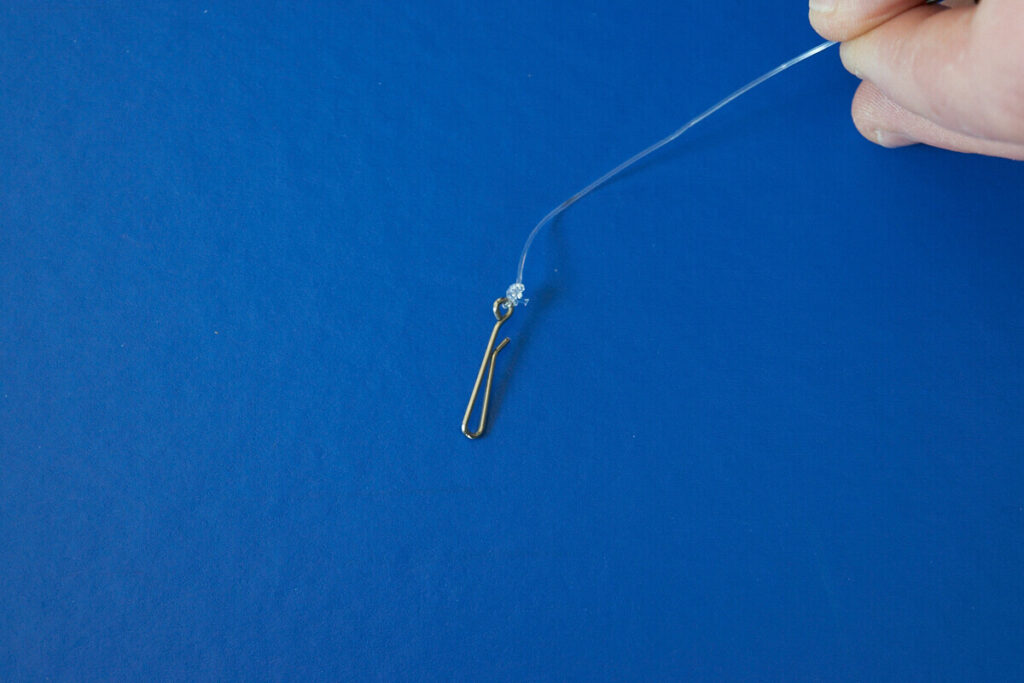
2. At one end tie on a Gemini Lead Link
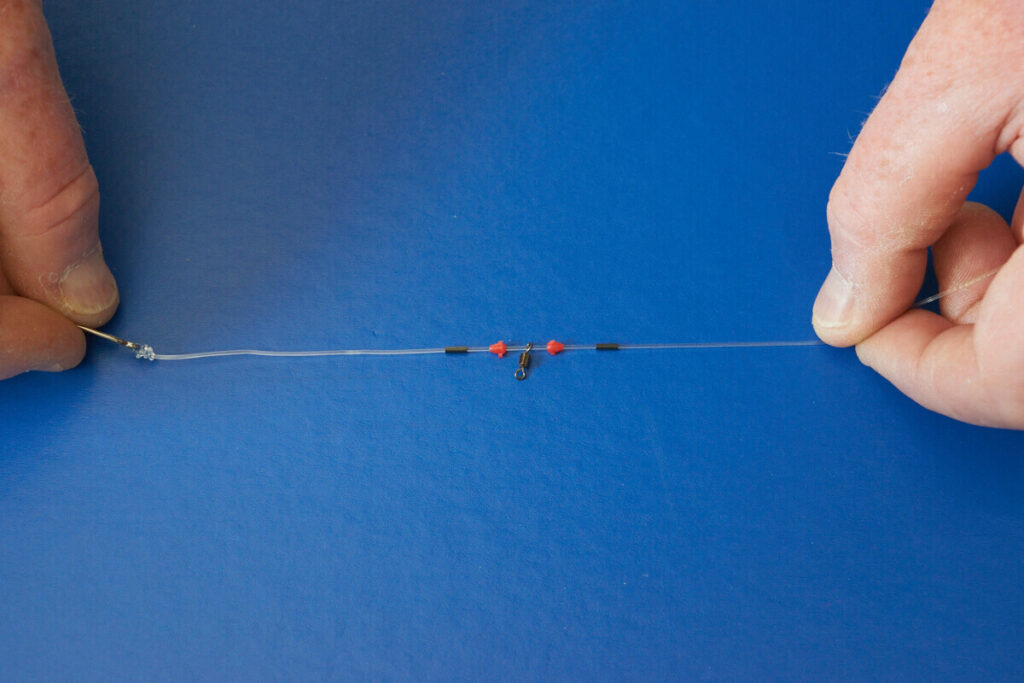
3. Slide on a rig crimp, a 3mm bead, a size 10 rolling swivel, another 3mm bead and a crimp. Crimp these in place tight behind the lead link.
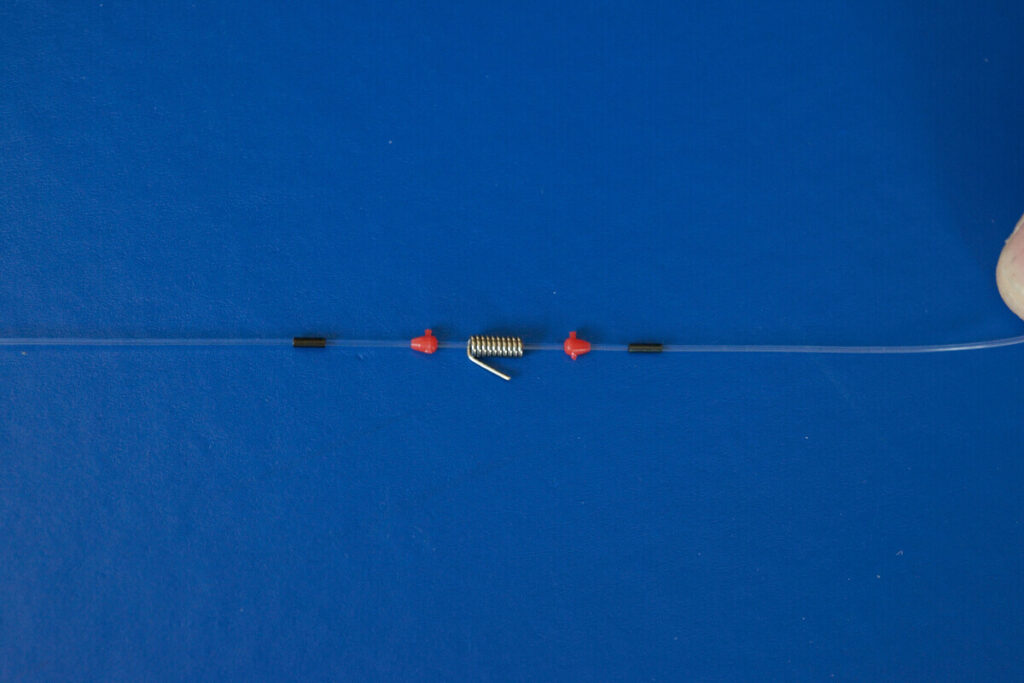
4. Slide on a rig crimp, a 3mm bead, an inverted bait clip, another bead and a crimp. Leave these loose for now.
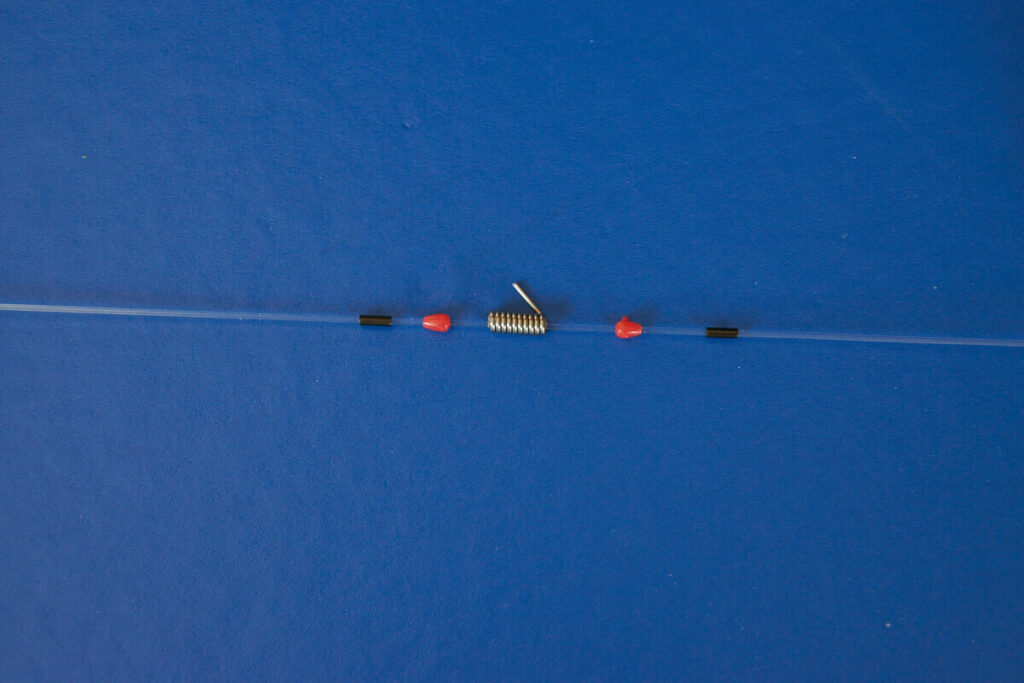
5. Slide on a rig crimp, a 3mm bead, a bait clip the right way up, another bead and a crimp. Leave these loose for now.
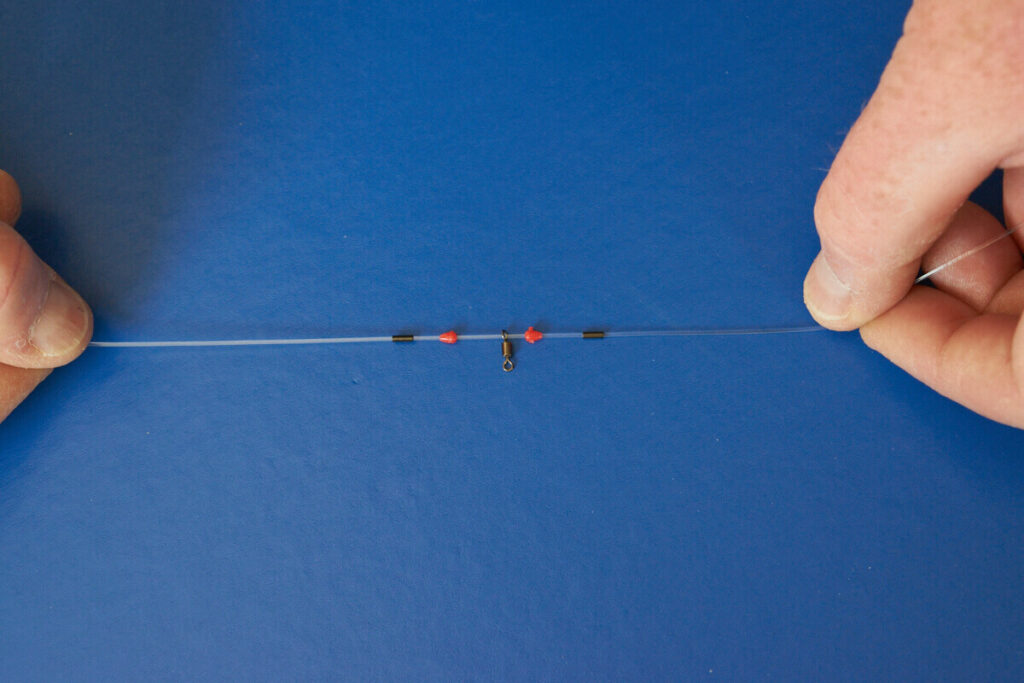
6. Slide on a rig crimp, a 3mm bead, a size 10 rolling swivel, another 3mm bead and a crimp. Again leave these loose for now.
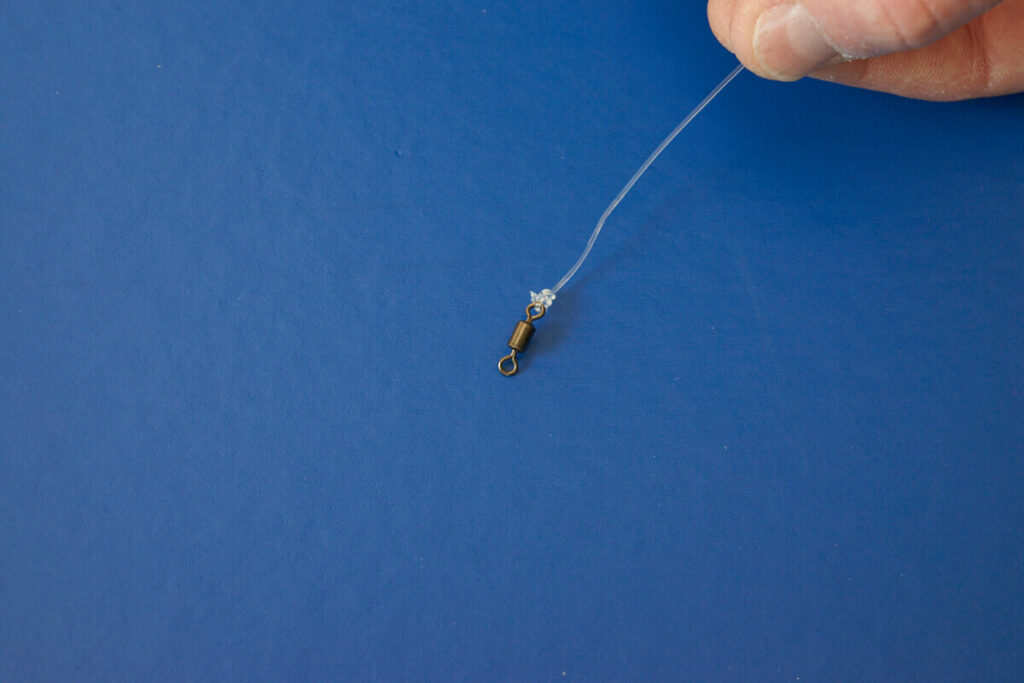
7. Finish the main rig by tying on a size 4 rolling swivel.
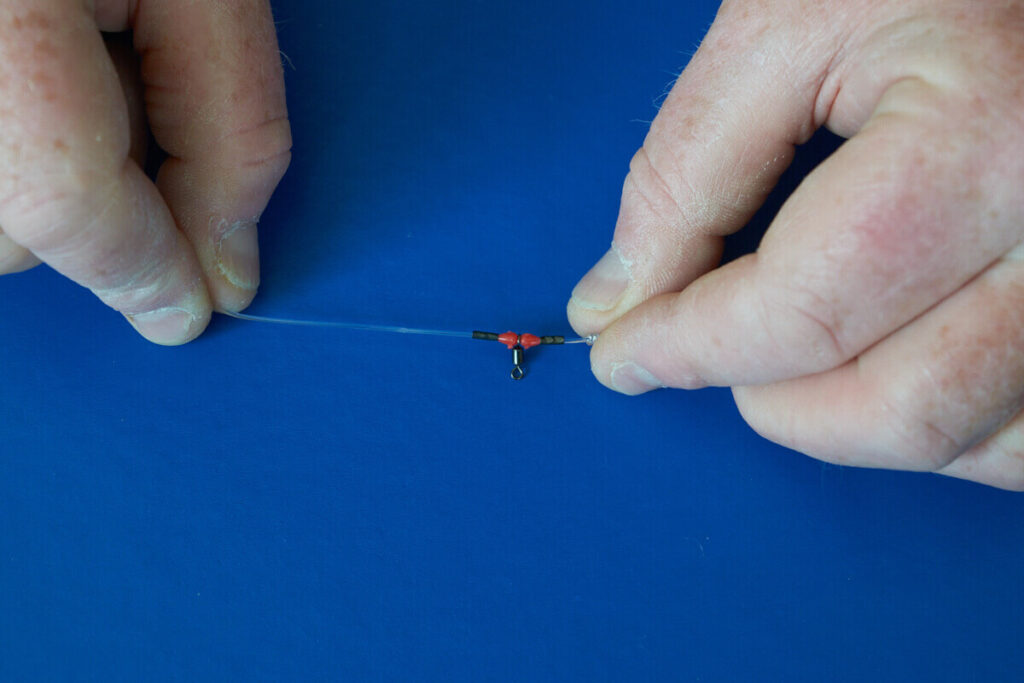
8. Crimp the top crimp, bead and swivel sequence in place just below the top size 4 swivel.
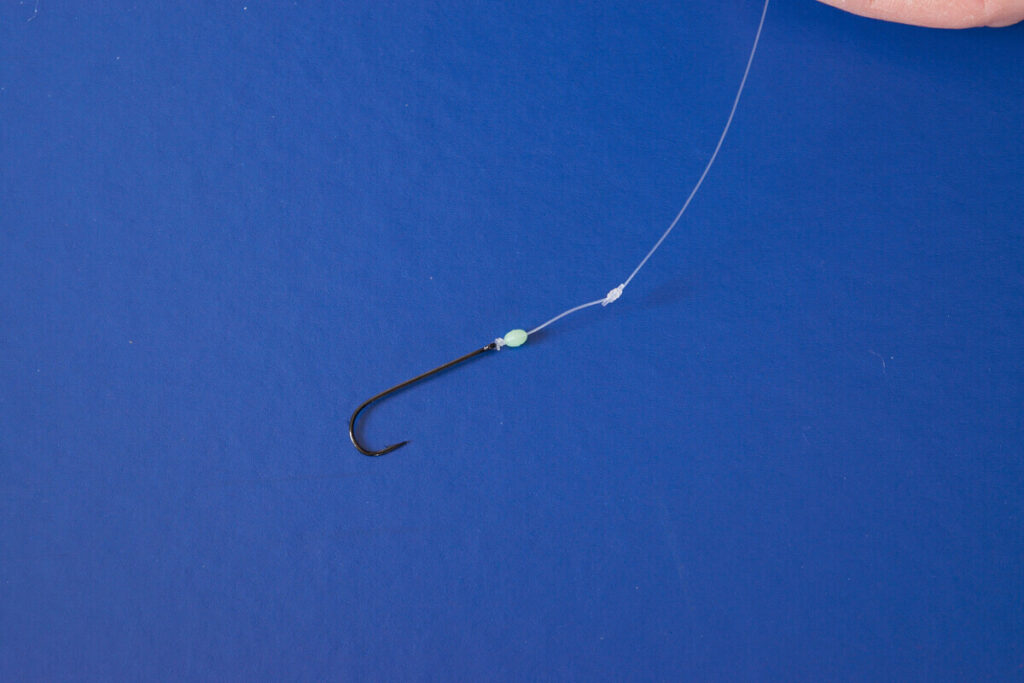
9. To both hook trace swivels tie on 15-inches of 20/25lb Fluorocarbon, slide on a rubber rig stop and a sequin, and finish with a size 2 Kamasan B940 Aberdeen hook.
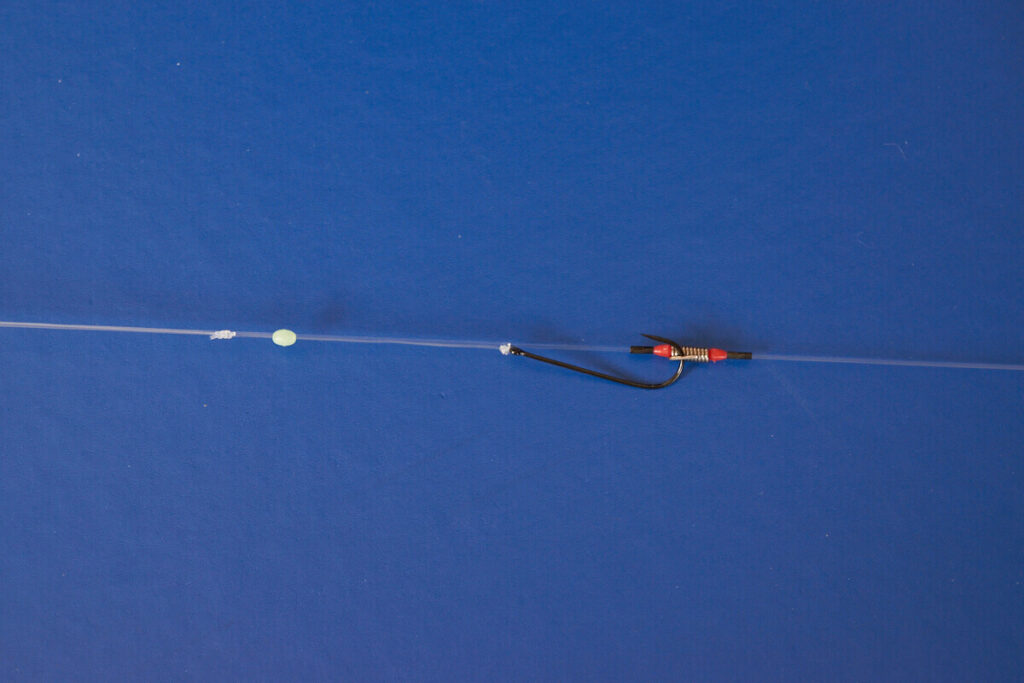
10. Put the bottom hook in the bait clip above it, slide the crimp, beads and bait clip up the trace until the hook trace comes just tight, then crimp the bait clip in place lightly just tight enough that you can move it under finger pressure.
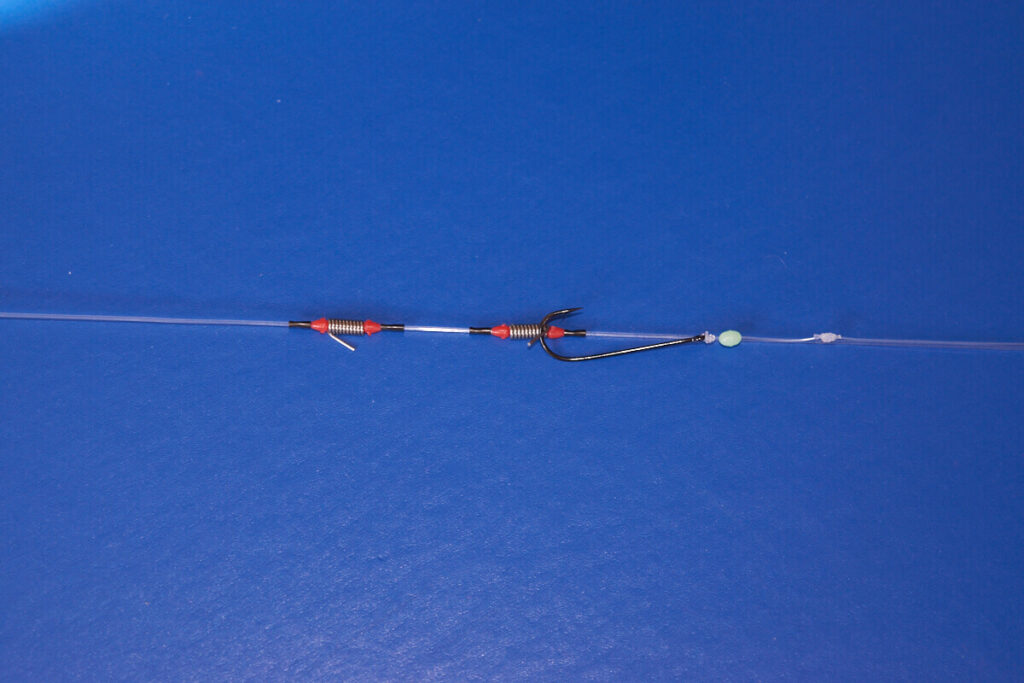
11. Put the top hook in the bait clip below, slide the crimps and bait clip down the rig body until the hook trace comes just tight, and again lightly crimp in place just so the clip can move under heavy pressure.
Just for clarity, some bait clips need to be crimped in place on the rig body, and we've described exactly how to do this. Other types of bait clips use rubber tubing which is slid onto the rig body line then the metal clip is pushed through the tubing, then the end of the bait clip is slightly bent upwards to stop it sliding out of the tubing under pressure. There is no need to crimp these rubber tubing bait clips in place so you can eliminate the beads and crimps. Both are very good, and it is a personal preference for which one you use.
The baits being clipped in place in the bait clips helps maintain excellent bait presentation after the cast by minimising bait damage during the flight. The rubber rig stop and sequin above the hooks keep the bait tight and compact around the hook and help preserve good bait presentation.
By only lightly crimping the crimps holding the bait clips in place, under pressure, the crimps will slide avoiding the hook traces stretching under casting load. If the hook traces stretch and elongates after a few casts, the hooks will not sit tightly in the bait clips and will fall free during the cast. Tubing type bait clips will also slide slightly under pressure but are easily readjusted for casting.
This rig is so popular because it has a wide gap between the hook traces. In deeper water when the line is at a steeper angle, or fishing the rig at close range, the top hook bait will be bouncing up and down in the tide and surf surge and will take any whiting that are slightly up in the water. The lower hook trace fishes hard on the seabed being positioned tight behind the lead weight.
2-Hook flowing trace
This is a great rig when fishing off piers, breakwaters and jetties, also off rock ledges that give access to deep water and when you'll be fishing a line that is almost vertical into the water. It puts two hook baits tight on the seabed and catches a lot of whiting.
This is a simple rig that casts well to medium range and should be mostly fished with a release wired lead. However, you can let this rig roll with the tide by using a plain lead, and this will often find deeper pockets in the seabed where the whiting concentrate to feed.
Bite detection is good on this rig as the line is direct to the rod tip through the Zip Slider Boom and indication is instant.
Smaller whiting are shoal fish and highly competitive. They get one chance to eat a bait and if they decline another fish will. For this reason, they take lugworm, ragworm, shellfish, prawn, mussel and most other baits you can think of. But generally, all these baits will target the smaller fish.
Once a whiting becomes an adult, they turn over mostly to a predatory lifestyle. If you want the bigger whiting in the shoal, and the bigger whiting generally, you need to use fish baits.
Mackerel is the best, frozen being good but obviously fresh if you can get it. This needs cutting into strips about 1.5-inches long but no more than 0.5ins wide. Pass the point of the hook through the skin side at the top of the strip, pull it all the way through, then bring it back through the bait from the flesh side so that the hook point sits near the base of the bait. For short-range casting, that's all you need to do. For longer range, add a few turns of thinner bait elastic around the bait to hold it in place.
Other fish baits, such as herring and bluey work well too, but bigger whiting show a definite preference for sandeel. Again, this needs to be a strip or sliver. The best way to prepare these is to take the whole fillet off the side of the sandeel, then, depending how big the fillet is, cut into suitably sized strips and present it on the hook as before. Smaller whole sandeels need the head and tail cutting off, then slide the sandeel body tail-first over the hook point, down the curve of the hook and up the hook shank, then secure with bait elastic.
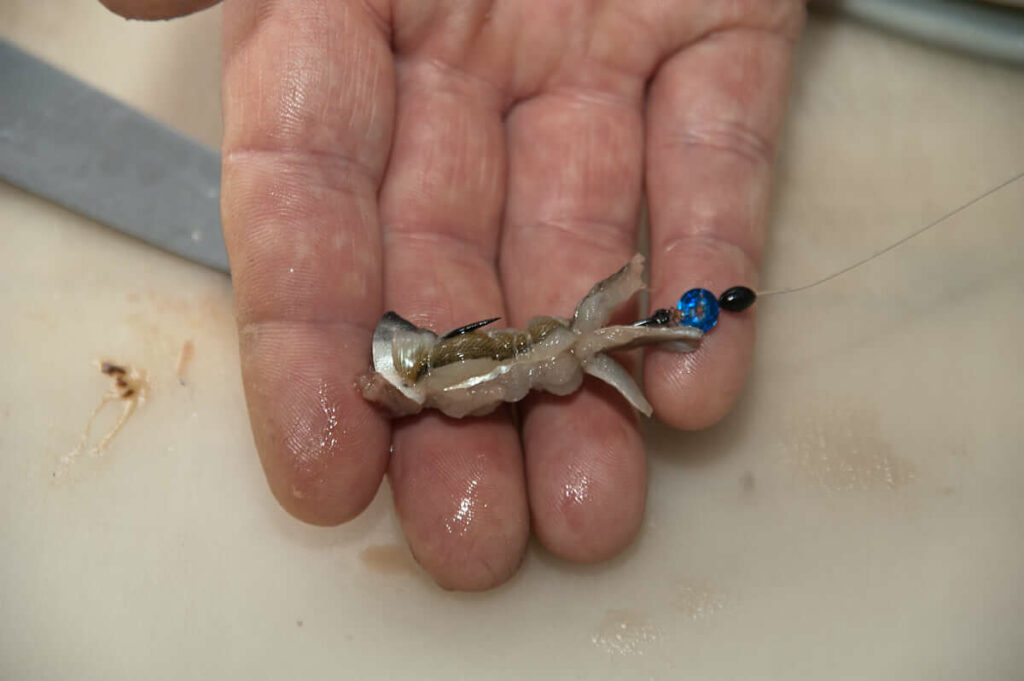
Fishing two rods side by side, in all situations, is a significant advantage. You can keep one in close and cast the other to long-range. This helps you decipher exactly at what range the bulk of the whiting are feeding. Once you find that range, you can fish both rods the same distance to maximise your catches. You may also find that the bigger fish are either further out, or, sometimes, very close in, especially in the New Year period.
There is often a no-man's land between the bigger whiting and general shoals. The smaller fish are aware that the bigger whiting are cannibals and will keep their distance with a clear separation line. More likely is that the bigger whiting will show during the tide's very middle period. Being bigger they can handle the faster flowing tide easier, so bear this in mind.
You can increase your catches by noting where those gullies and gutters are along the beach. Try to take a landmark bearing using a sand dune or even by putting a pile of pebbles on the shingle so you at least have the direction and can then make a judgement on distance as the tide floods in and pushes you back. Getting baits into those gullies will make a big difference.
Whiting give a series of energetic rapid knocks on the rod tip. Usually, when you see this, they have already hooked themselves against the weight of the lead. If the whiting are feeding eagerly, leave that first fish out for a further 30 seconds and it will usually draw one or two more to the other baits, which is the way to catch a full house on a 3-hook rig.
When the tide is flowing bites are easy to hit, but as the tide slackens, if you're using short hook lengths, then you will see plenty of bites but probably miss a lot of fish. This is because the fish do not have the weight or the velocity as they swim to set the hook. You can improve your hook up ratio at this time by lengthening your hook lengths to say 18-inches, and this gives the whiting the room to pick up the bait as they approach from downtide, and as they turn back into the tide and pick up a bit of impetus they come up tight against the hook length, and the hook gets better penetration.
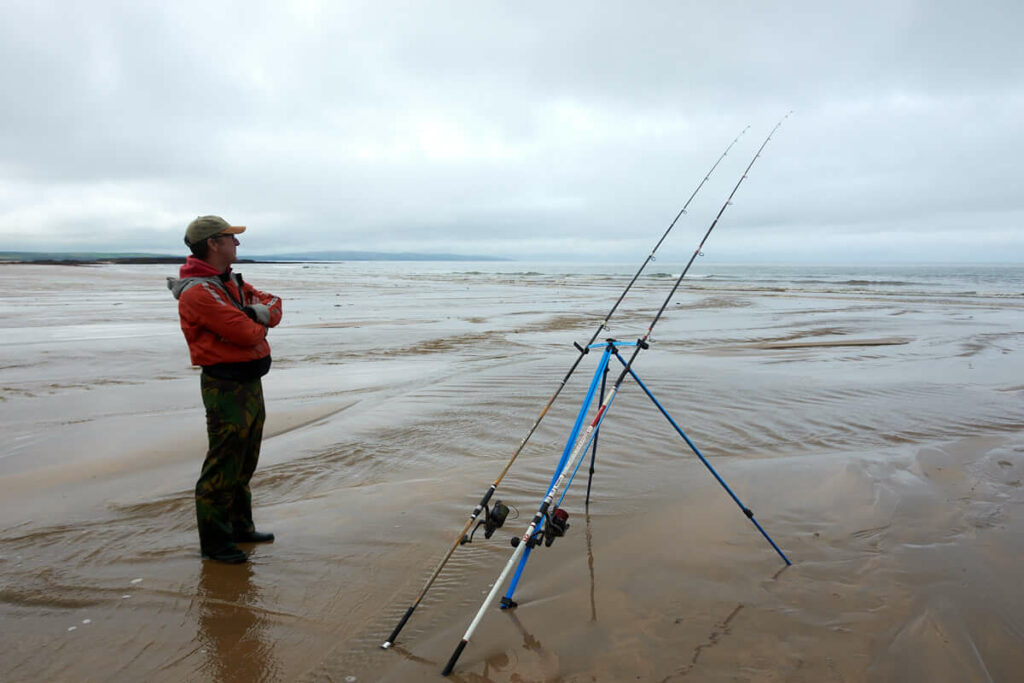
Offshore whiting have a much more varied habitat. They are found in numbers in deep water over clean or broken ground, occasionally in amongst reef ground where sandy patches occur.
They also frequent wrecks, with the smaller fish sitting just off the wreck, usually in the quieter water on the edge of the tide run as it works over the wreck, but with the bigger ones closer into the metal.
They are also common inside sandy bays flanked by cliffs and rocky headlands.
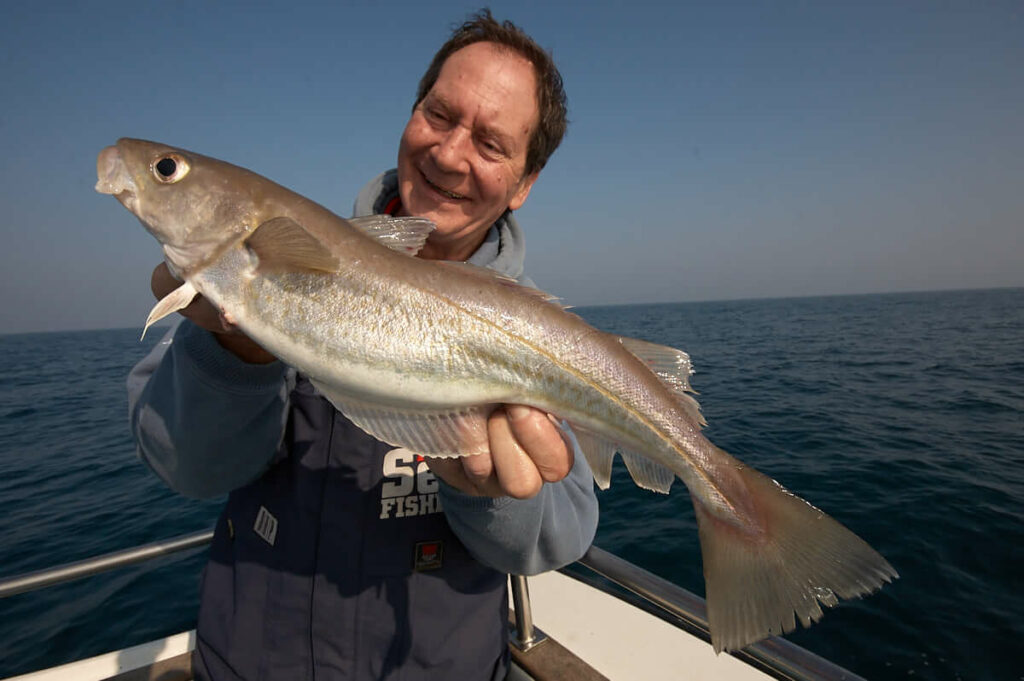
Its immaterial really what size the tide is offshore, especially in deeper water. The whiting will feed all the time. But the tide size will affect the boat's drift speed, so in deeper water, the smaller tides will be the better ones to fish.
Boat fishing tight inshore, it can be different with the bigger tides bringing the fish closer in, and the faster water flow helping you cover more ground as you drift.
Regards the stages of the tide, then it's much the same as it is for shore fishing with the slack water periods at low and high water relatively poor, but with bites picking up appreciably as the tide flow increases with the middle hours of the tide being generally the best.
On the smaller tides when the flow is relatively light, seek out headlands that jut out into the sea and fish inside these. The land jutting out will deflect and increase the tide's flow enough to interest the whiting and keep the shoals more concentrated.
Inshore, in shallower water, look for the calmer weather periods with relatively settled seas. Light winds, either off the sea or off the land, prove to be best. During periods of rougher weather the whiting move out into deeper water and it takes a few tides or several days as the seas settle for their numbers to build again.
Offshore, in deeper water, a period of unsettled seas will not affect the whiting's feeding habits.
The cloudier days, especially inshore, offer the best conditions with bright sunshine being less productive, particularly in water less than 100-feet deep where light penetration becomes an issue.
For general inshore fishing, a lighter 12/15lb class rod around 8ft in length will handle most situations when drift fishing over clean and broken ground. A reel to suit this rod would be a smaller multiplier, say the Penn Fathom 15 series or similar and load with 20 to 30lb braid, plus a short 25 to 30lb fluorocarbon leader twice the length of the rod. This outfit will handle lead weights up to 8ozs or so. This is also the ideal outfit to fish lures with, and more about that shortly.
In deeper water, again go for a 7ft 6in to 8ft rod, but the line class needs to be 20lbs, though a modern 20/30lb braid rod suits this type of deep water fishing better. Go for the same Penn 15 sized multiplier but load with 30lb braid and a 30lb fluorocarbon leader. This will fish lead weights up to 12ozs, but if you need much more than that, then the whiting fishing will become hard work.
Over shallow inshore grounds where tide runs are very light, such as in sheltered bays, a light 6lb class rod armed with a 6500 sized multiplier and 15lb mono, or even a small 4000 sized fixed spool loaded with 20lb braid will maximise the fun with whiting. We would suggest fishing that short fluorocarbon leader of 20lbs just to protect the braid line and create that visual separation between the rig and coloured braid.
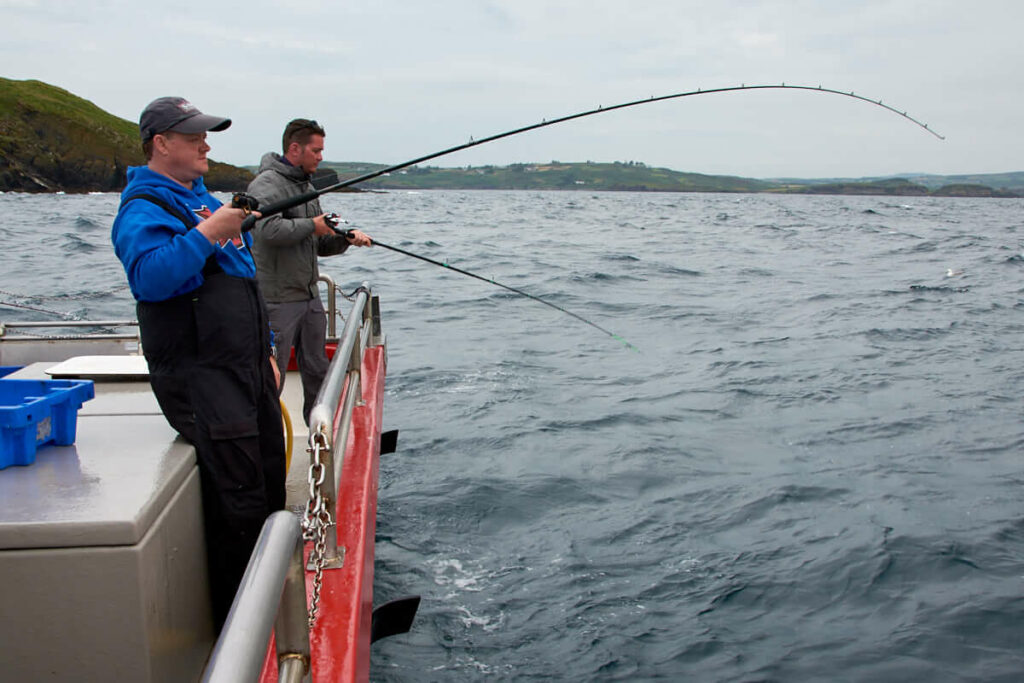
Rigs for offshore whiting need to be simple and tangle-free for fast dropping down to the seabed. The first rig is a 2-hook drift rig that is exceptionally effective for whiting, and a host of other species too. This is how we tie it.
The choice of boom is important, too. It must be a stiff plastic-type about 3 to 4-inches long and made from a high-density plastic, not a softer or longer boom that will bend in the tide as it needs to present the top hook trace well away from the main rig body line. These tough booms will also easily stand landing larger fish, including big rays and turbot should they happen along.
Also, the long gap between the two hook baits ensures that if two fish are hooked at once, they cannot easily come together and tangle the rig. This is very important!
2-Boom boat drift rig
If you just compress the crimps enough to hold the boom and beads in place, but with finger pressure move the crimp up and down, then you can easily move the booms to new positions. For instance, if you are fishing the booms one near the top swivel and the other roughly in the middle of the rig, and all the fish are coming to the middle boom, then slide the middle boom down to be just above the lead link and slide the top boom down to the middle. You now have two baits in the feeding zone and can double your catch. It works in reverse too, if the majority of the fish are taking the top boom bait.
The rig is best fished with luminous beads. The rig was originally designed for deepwater drift fishing, and the use of luminous beads helps highlight the bait in deep, dark water. The silver spoon, which proves highly effective in clear water, suggests light levels at depth are enough to give a reflection that will attract fish, though vibration from the spoon is also important.
The spoon is mounted above the beads as we want it to have some ability to revolve. If you mount it with beads above it, the weight of these pressing against the spoon via water pressure limits its ability to revolve. This is an important point.
The fluorocarbon hook lengths are also important as they are a little stiffer than mono and will not tangle as easily, plus have a higher abrasion resistance when in contact with the seabed and also from the needle-like teeth of whiting.
Keep the hook lengths no longer than 12-inches to minimise tangles. It is best to use a stiffish boom as this helps keep the bait away from the main rig body line.
Some anglers make the mistake of fishing this rig vertically with a heavy lead, and it will catch like this. It is though, much more effective used with leads just light enough to keep in contact with the seabed and letting plenty of line out to fish the rig at a shallow angle, much as we did with the other rigs. This presents the baits both naturally and at slightly different heights to offer different presentations to take whiting both on and just off the bottom.
If you want to add more illumination to the rig, fish it with a luminous lead weight. This is especially popular in Ireland and can increase the catch rate in deep water.
Very effective for whiting, in all boat situations, are simple baited feathers. In shallower water use the flashier silver tinsel type baited with small strips of mackerel, herring, bluey or sandeel. The luminous Hokkai lures with luminous plastic bodies work well in deeper water, again baited with fish baits. These are fished just the same, with line paid out and the lead weight tripping across the seabed in constant contact.
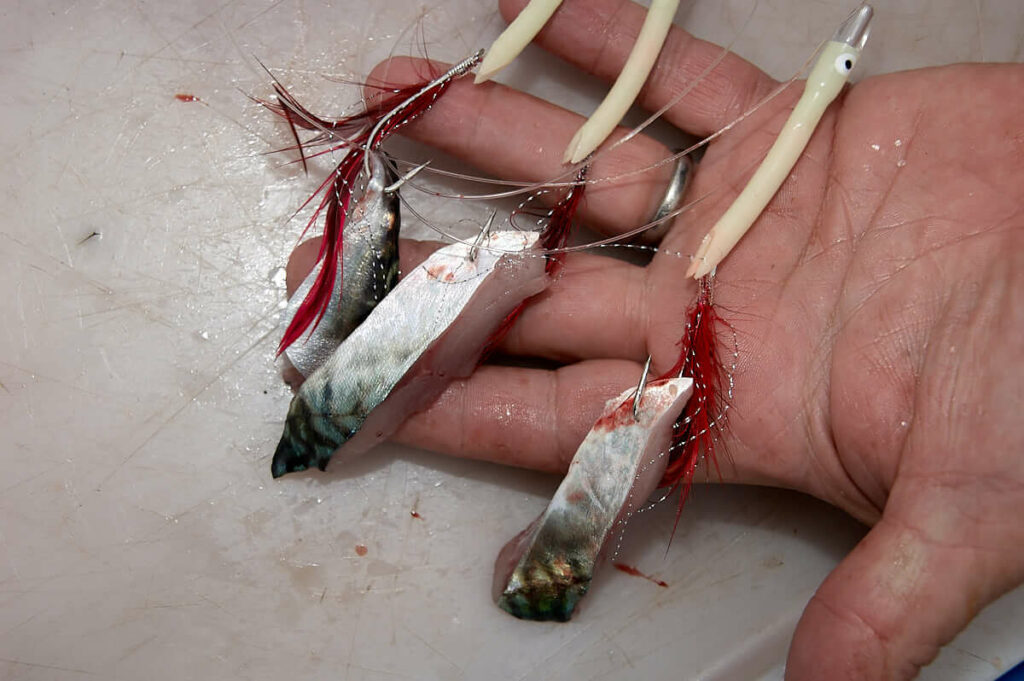
Both inshore and offshore stick to fish baits. Adjust the size accordingly going for strips about 1.5ins x 0.5ins close to land, but when in deeper water use bigger 2 to 2.5-inch strips again about 0.5-inches wide.
Pass the hook point through the top of the strip through the skin side and fully through, then at least the full length of the hook down the length of the fish strip, bringing the hook point back out to fully expose it on the skin side. This presents the strip lengthways and helps it to move more naturally when it's drifting across the seabed.
If you're short of mackerel, remember whiting are cannibals and will eat their own kind, so a strip of whiting can also be deadly.
Drift fishing
Fishing the seabed effectively will depend on the speed of the boat's drift and the depth of the water. Typically a minimum of 50-yards of line should be released after the lead weight is felt to hit the seabed, but release more if need be, up to 100-yards plus is not uncommon if the drift is fast. The aim is to maintain constant contact with the seabed, which can be felt through the braided line on the rod tip as the weight drags across the seabed.
The more line you let out the flatter the angle of the rig. Having the bottom bait directly in front of the Zip Slider and weight on the 2-hook drift rig described above and the near-flat angle of the rig with a lot of line paid out ensures both baits will be in contact with the seabed. The same applies when fishing baited feathers.
Also, continually readjust the weight of the lead weight. This should be heavy enough to keep in contact with the seabed and not occasionally bounce or lift upwards as the speed of the drift increases. Equally, reduce the size of the weight as the drift speed reduces to maximise bite detection.
When drift fishing in shallower water bites are felt as a fast rattle, and it's just a case of lifting the rod tip to set the hook. You may get the fast rattle on the rod tip in deeper water, but often all you'll feel is the weight increase on the rod tip, and the fish will be hooked.
Lure fishing for big whiting
We've already learnt that whiting are very predatory, and especially the bigger fish over 2lbs, they're total diet is made up of live fish. We can target these fish offshore using soft plastic shads and leadheads. It's a specific technique, but it proves deadly for these bigger whiting.
Use the 12/15lb class rod and reel combination where possible, but it works just as well with the heavier outfit.
The rig is simple. It's a variant of the famous Whitby rig.
Using the lead head, this rig will not tangle even when dropped fast. As the lead weight hits the seabed, you reel in about 8ft of line and the lead head is still dropping down, and this pulls out any potential tangles leaving the hook length to fish correctly.
You need to select a weight by trial and error that will keep fairly tight to the seabed when drifting. This is important as too light a lead weight will lift too high up in the water column and outside the whiting's feeding zone.
When the lead weight hits the seabed, release about 50-yards of line. Then let the line tighten and lift the weight and lure up off the seabed. Wind in very slowly but occasionally lift the rod tip to make the lure jerk forward. After say 20-yards of retrieve, drop the tackle back to the seabed and start again. This puts the lure right in the main feeding zone of these bigger whiting looking for small prey fish. Out of all the whiting tactics we know, this is the one to catch the biggest fish.
This above technique works both over clean sandy ground and close to wrecks, and when whiting are running along the edge of a reef and on the junction of sand and rock.
Bites are felt by a gradual increase in pressure on the rod tip then you'll feel the kick of the whiting as it tries to swim away with its prey.
Often accused as being a less desirable species, along with flounder, whiting is often one of the first fish an angler catches, and in that, it has a special place in the heart of many sea anglers.
It is a willing feeder and gets the rod tips rattling when other species prove elusive. Even the most experienced and diverse sea angler, most winters, will have one or two nights on a "whiting bash". A night on the whiting can also restore lost confidence in those of us that might have suffered a tough time during recent fishing trips.
Although whiting is the common name, it can be called merling in some areas. Until the late 1900s whiting were classed as cheap and a poor man's food and often used for cheap pet food.
In current times the fortunes of whiting have improved with it being more highly valued as a food fish due to its delicate flesh and slightly sweet flavour that requires minimal cooking time.
About whiting
Whiting identification
Without experience, the whiting is most likely to be confused with its near cousin the cod. But there are simple things to look for to identify one from the other.
The whiting's head is narrower and more pointed than the cod, which is generally heavier built in the head and body. All cod have a chin barbel or feeler on the lower jaw, but this is only small and evident in juvenile whiting, adults lose this. The upper jaw slightly protrudes the lower jaw. The whiting has three dorsal fins like the cod, and these are closely joined at their bases. It also sports two anal fins, the first being the longer, which originates beneath the middle of the first dorsal. On the cod, the first anal fin begins either inline or just behind the second dorsal fin's forward edge.
The whiting's colouration in shallower water and over sand is a light brown or fawn with silvery-white sides. There is also a conspicuous dark spot positioned at the upper front edge of the pectoral fin and just rear of the gill-plate. The whiting tends to have a darker brown to greeny-blue back in deeper water and can be more silvery on the sides.
The majority of whiting are sub 2lbs, but they can achieve lengths of 30-inches (76cms) and weights approaching 10lbs, though this is now unlikely due to commercial overfishing.
The spawning period is extended between January and July, with fish in the southern side of their habitat more likely to breed in the colder months and early spring. The smaller juvenile fish up to 1.25-inches in length or so often form small shoals under live jellyfish using the tentacles for protection.

Whiting distribution
Whiting have an extensive distribution range being found throughout the northern half of the Mediterranean, north along the European coast, throughout Norway and just into Russian territory. They are also found in a thin extended line from The Faroes and all around Iceland.
They are common throughout the UK with large concentrations found in the English Channel where some of the biggest whiting are caught, also inside the North Sea, the Irish Sea and the west of Scotland. Again they are common all around Ireland with some bigger fish likely off the southwest corner of Ireland, also off Donegal and Northern Ireland.
Whiting diet
Juvenile whiting eats mostly crustaceans such as small shrimps. The adults have serious pin-like teeth giving the game away that they are true full-on predators eating typically, small whiting, poor cod, pouting, small herring, small flatfish and sandeels.
They are also happy to scavenge on the seabed and will also take shellfish and molluscs if they come across them.
When tight inshore their diet includes all manner of worms including lug and ragworm, mussel, cockle, sand clam, and any small fish they come across.

Shore fishing for whiting
Season
Smaller whiting can be caught inshore pretty much all the year-round. However, the traditional whiting season is from mid-September when the vanguard of the main whiting shoals first appear. Their numbers grow quickly and by early October, and especially if the first frosts are on the land, their numbers escalate quickly. The peak month is November to mid-December when they gradually start to thin out, and by the end of January, the best is over.
That said, late January and throughout February there can be a run of bigger fish between 1 and 2lbs, sometimes bigger. This applies both on the shallow surf beaches and fishing deeper water from man-made structures or rock ledges.
Habitat
Whiting have specific habits when it comes to the type of ground they prefer, and we need to look at this in detail to get the best from the fishing.
Sandy surf beaches
On sandy surf beaches, they will come into relatively shallow water and can often be found in the surf from 30-yards out if the weather is calm with a gentle surf. They do not like rough conditions and big surfs, so expect the fish to be further out in these conditions.
On shallow beaches, there is usually a defined low water bank or definite lift in the ground feature. This is where the typical wave action hits the shore at the mean low water level. The whiting stays out beyond this until the water depth on the main beach increases, then they will move in, in numbers.
Around the mid-tide time they will feature across a wide area of the beach, typically being concentrated in areas where there are depressions in the sand, or better still, deeper gullies and gutters that run parallel along the beach. These gutters collect and hold food and are real hotspots.
A good tip on a shallow surf beach with a shingle shoreline is to look for areas where large amounts of waterborne debris collect at the high water mark. This indicates where a tidal current comes ashore, and fishing out into this can be a great spot to try.
Other good spots to try are close to rocks that meet sand, especially areas where cliffs are at the end of beaches. These can produce the bigger whiting which are looking for smaller fish that try to use the rocks as cover.

Steep-to beaches
These tend to be easier to fish as the shoals tend to be widespread over the whole area. If sea currents create any known depressions or scooped out areas, fish them. Other good spots are where a point of shingle or sand juts out into deeper water. Whiting like to sit just inside the edge of the current created as the tide works around the point and their numbers will be heavier here.
And don't forget those wash-up areas on the shingle where the current hits the shore. Again this is a top spot to try.

Man-made structures
Piers tend to see a gutter directly under the pier structure that is usually exposed stone, boulders or mussel beds. You need to cast a fair way away from the pier out into deep water and over the cleaner ground to find the whiting usually. If you can identify any areas of rising sandbanks or ridges, these can be excellent.
It's much the same from breakwaters. These tend to give on to deeper water, and casting away from the structure out onto clean ground is bound to see fish caught. However, don't neglect the ground immediately out from the structure but close into the rock foundations, which is often the place the bigger whiting are caught.
If the structure gives casting access to a deeper channel used by boats entering a harbour, this will be the hotspot throughout the flooding tide and is also the exit route for whiting using it to return seaward as the tide ebbs out. The extra depth and tide flow will concentrate the shoals of whiting here.
Also try to locate, by casting, areas where mussel beds appear due to the tide running round or through man-made structure displacing sand and fish to the side of these. Also areas of shingle where sand meets it. Any break up in the natural seabed feature can and will attract whiting.

Rock ledges
On the open coast rock ledges, it's the more open bays that see the best of the whiting fishing. They tend to sit out in the deeper water, then as the flood tide starts to move in, they follow and fill the bays covering every inch of clean ground.
Other good spots are where sandy patches run in between rougher ground. These are often good areas to pick up bigger than average whiting, especially in the post-Christmas period. Probably the best tip is to try to locate areas where a tide run is deflected by a small headland or reef and fish any clean ground close to this.

Tides
In deeper water, and especially off a man-made structure, you'll catch whiting whatever the tide's size, but generally the better catches will be taken on the bigger tides. As is so often the case, it's the tides rising towards the highest springs that produce the best fishing. When the tides are falling back to neaps, then the whiting's overall numbers will be lower.
It's much the same from the steep-to beaches with most tides producing fish, but again, it will be those climbing tides that produce the best fishing. Though whiting will show up on the neaps on surf beaches, it's the bigger tides with their faster-moving water and the overall greater depth towards high water that will bring the fish in.
On shallower surf beaches at low water, they tend to be well out, possibly on the fringe of your maximum casting range, but good casters can still enjoy fair catches at this time. As soon as the tide starts to flood the shoals will begin to move closer and closer to shore literally following the tide in up the beach and you'll catch at medium range consistently through the middle hours of the tide. The hour before high water they will be from 30-yards to 70-yards out and really concentrated in numbers. However, as soon as the ebb tide begins, they will quickly filter out into deeper water, and again it's the bigger casters that usually do best at this time.
Generally speaking, you'll find on all venues that the whiting bites will be slow until the tide starts to flow more strongly with the best period the middle three hours of the flooding tide. The ebb bites will be at range and fewer in number, but again the ebb's middle hours will prove best.
Weather patterns
Their preference is for calm weather periods with flat seas and a light surf on both shallower surf, deeper steep-to beaches and when fishing from man-made structures. The rougher the seas, the further the whiting push out. After periods of rough weather, it also takes a few tides for the sea to settle and the whiting to return in numbers.
Ideal conditions are big tides with both low and high water in the dark during prolonged periods of calm seas. Frosty nights are perfect for shore whiting. The TSF team look to fish tides that begin to flood in full darkness with high water in darkness and that light onshore or even a gentle offshore wind for the very best results.
Tackle
Whether fishing from surf beaches, deeper beaches, man-made structures or off the rock ledges, whiting fishing generally dictates you will need to cast a fair way for consistent results. Also to combat faster-flowing tides and deep water, plus lift fish from the sea if you're on a pier or breakwater.
All these scenarios dictate using a typical UK beachcaster rated 4-6oz between 12ft and 13ft in length. A 6500 type reel loaded with 15 to 18lb mono line and a 60lb shock leader is the right choice on the shallower beaches. If you're fishing from deeper steep-to beaches, man-made structure and rock ledges, then a reel with more gear power is needed, and the Penn 525 series fits the bill perfectly, or reels from other manufacturers built with similar tough gears. Load this reel with 18 to 22lb mono and that ever-important 60lb shock leader.
If you prefer fixed spool reels, then the rod to go for is a continental style 14ft matched to a 7500 sized reel with a Long Cast type spool. These should be loaded with 30lb braid and either a 60lb tapered shock leader, or an 80lb braid leader knotted to the main braid using two back to back Grinner knots.
In calmer seas some anglers use a 2-4oz bass rod and a small 5500 or 6500 sized multiplier loaded with 15lb line and 30lb mono shock leader, alternatively a 5000 sized fixed spool reel and 30lb braid with no leader. This lighter approach using leads up to 3ozs is perfect for medium range fishing off the beaches, even when fishing three hook rigs and taking whiting three at a time.
Sometimes a lighter spinning rod about 9 to 10ft with a 4000 fixed spool, 20lb braid and light 1oz lead with a single flowing trace is an option in calm weather on the shallow beaches targeting just one fish at a time. This very light tackle gives that bit more sport, and sizable whiting will let you know it's there on this gear.

Rigs
Many rigs will take whiting, but specific ones for specific situations will give the best results.
3-Hook flapper
This is the best rig for general beach fishing, either shallow surf beaches or deeper steep-to beaches. It's easy to build, too!

1. Start with about 64-inches of 60lb clear mono. Tie on a Gemini lead link at one end.

2. Slide on a rig crimp, a 3mm oval rig bead, a size 10 swivel, another rig bead and a crimp. Repeat this sequence to give you three full individual sets of crimps, beads and swivels. Leave these loose for now.

3. Complete the rig by tying on an inverted (upside down) Gemini lead link to the tag end of the rig body line.

4. The first hook trace swivel needs to be placed just one inch below the top Gemini lead link. The middle swivel should be positioned exactly 17-inches below the top swivel, and the third again 17-inches down from the middle hook trace swivel.

5. The top hook trace needs to be the longest at about 15-inches, the second hook trace measures 13-inches, and the bottom hook trace is the shortest at just 10-inches. All hook traces are made from 20 mono or fluorocarbon and are finished with a size 2 Kamasan B940 hook for general species.
A major feature with this particular rig is that the three hook snoods are positioned to present the baits differently to target specific species. If you fish the rig to a tight line direct to the rod tip, the lowest hook will be on the seabed, or at worst in a lively shallow surf, lifting up and down naturally bouncing on the ground.
A common mistake is to make all three hook lengths the same length. The hook snoods' lengths on this reversible rig are deliberately tied as different lengths. When fishing to a fairly tight line at close to medium range, the rig's full length will not sit flat on the seabed. Only the bottom hook is fishing hard on the bottom and consistently catching fish. If tied on too short a snood, the other two hooks are suspended up in the water column and less likely to catch.
This rig is tied using a longer top and middle snood. This helps keep the baits tighter to and in contact with the seabed and inside the main fish-feeding zone, even when the rig body length is lifted by passing surf tables, without the need to fish a slightly slack line between the rod tip and lead weight. The longer snoods also allow the baits to move more naturally.
You can also deliberately fish to a very tight line, and this will help lift the top two baits off the seabed periodically when a surf table passes and can sometimes better target the more active whiting.
By having a clip link at both ends of the rig body, you can literally reverse this rig around. If all the fish are falling to the bottom hook with the lower hook trace positioned well up above the lead, reverse the rig so that what was the top hook, now fishes tight behind the lead. The middle hook is now positioned where the first one was before you reversed the rig around. This puts two hooks in the feeding zone, giving you the chance to double your catches.
Always fish this rig with a released wired lead. The baits need to be anchored for the whiting to easily follow the baits scent trail, plus when they take the bait, they come up hard against the lead, creating a self-hooking effect.
1 Up/1 Down clipped rig
This 1 Up/1 Down rig is the best for fishing from man-made structures and rock ledges but is also employed on the beaches when whiting are at long range. The bottom hook trace fishes hard on the seabed where the bulk of the whiting are feeding, but the top hook length suspends slightly up in the water and will still be taken. When fishing from man-made structure, after casting, you can also fish this rig to a slightly slack-line, just releasing 2 or 3ft of line to create a downward bow. This drops the top bait tighter to the seabed and though you will see the bite on the rod tip, a better way is to watch the bow in the line to lift as this is the initial indication of a bite.

- Begin with 46-inches of 60lb clear mono.

2. At one end tie on a Gemini Lead Link

3. Slide on a rig crimp, a 3mm bead, a size 10 rolling swivel, another 3mm bead and a crimp. Crimp these in place tight behind the lead link.

4. Slide on a rig crimp, a 3mm bead, an inverted bait clip, another bead and a crimp. Leave these loose for now.

5. Slide on a rig crimp, a 3mm bead, a bait clip the right way up, another bead and a crimp. Leave these loose for now.

6. Slide on a rig crimp, a 3mm bead, a size 10 rolling swivel, another 3mm bead and a crimp. Again leave these loose for now.

7. Finish the main rig by tying on a size 4 rolling swivel.

8. Crimp the top crimp, bead and swivel sequence in place just below the top size 4 swivel.

9. To both hook trace swivels tie on 15-inches of 20/25lb Fluorocarbon, slide on a rubber rig stop and a sequin, and finish with a size 2 Kamasan B940 Aberdeen hook.

10. Put the bottom hook in the bait clip above it, slide the crimp, beads and bait clip up the trace until the hook trace comes just tight, then crimp the bait clip in place lightly just tight enough that you can move it under finger pressure.

11. Put the top hook in the bait clip below, slide the crimps and bait clip down the rig body until the hook trace comes just tight, and again lightly crimp in place just so the clip can move under heavy pressure.
Just for clarity, some bait clips need to be crimped in place on the rig body, and we've described exactly how to do this. Other types of bait clips use rubber tubing which is slid onto the rig body line then the metal clip is pushed through the tubing, then the end of the bait clip is slightly bent upwards to stop it sliding out of the tubing under pressure. There is no need to crimp these rubber tubing bait clips in place so you can eliminate the beads and crimps. Both are very good, and it is a personal preference for which one you use.
The baits being clipped in place in the bait clips helps maintain excellent bait presentation after the cast by minimising bait damage during the flight. The rubber rig stop and sequin above the hooks keep the bait tight and compact around the hook and help preserve good bait presentation.
By only lightly crimping the crimps holding the bait clips in place, under pressure, the crimps will slide avoiding the hook traces stretching under casting load. If the hook traces stretch and elongates after a few casts, the hooks will not sit tightly in the bait clips and will fall free during the cast. Tubing type bait clips will also slide slightly under pressure but are easily readjusted for casting.
This rig is so popular because it has a wide gap between the hook traces. In deeper water when the line is at a steeper angle, or fishing the rig at close range, the top hook bait will be bouncing up and down in the tide and surf surge and will take any whiting that are slightly up in the water. The lower hook trace fishes hard on the seabed being positioned tight behind the lead weight.
2-Hook flowing trace
This is a great rig when fishing off piers, breakwaters and jetties, also off rock ledges that give access to deep water and when you'll be fishing a line that is almost vertical into the water. It puts two hook baits tight on the seabed and catches a lot of whiting.
- Begin with 30-inches of 60lb mono.
- At one end, tie on a size 2 rolling swivel.
- Slide on a 5mm bead, a Zip Slider Boom and another 5mm bead.
- To the free end of the 60lb mono, tie on a size 2 rolling swivel.
- To the lower swivel tie on 36-inches of 25lb mono or fluorocarbon.
- Form a 26-inch loop in the hook length and secure the loop with a figure-of-eight knot.
- Cut the loop to form a short 6-inch hook length at the top and a longer 20-inch hook length trailing below it.
- Add size 2 Kamasan B940 hooks to each hook length.
This is a simple rig that casts well to medium range and should be mostly fished with a release wired lead. However, you can let this rig roll with the tide by using a plain lead, and this will often find deeper pockets in the seabed where the whiting concentrate to feed.
Bite detection is good on this rig as the line is direct to the rod tip through the Zip Slider Boom and indication is instant.
Baits
Smaller whiting are shoal fish and highly competitive. They get one chance to eat a bait and if they decline another fish will. For this reason, they take lugworm, ragworm, shellfish, prawn, mussel and most other baits you can think of. But generally, all these baits will target the smaller fish.
Once a whiting becomes an adult, they turn over mostly to a predatory lifestyle. If you want the bigger whiting in the shoal, and the bigger whiting generally, you need to use fish baits.
Mackerel is the best, frozen being good but obviously fresh if you can get it. This needs cutting into strips about 1.5-inches long but no more than 0.5ins wide. Pass the point of the hook through the skin side at the top of the strip, pull it all the way through, then bring it back through the bait from the flesh side so that the hook point sits near the base of the bait. For short-range casting, that's all you need to do. For longer range, add a few turns of thinner bait elastic around the bait to hold it in place.
Other fish baits, such as herring and bluey work well too, but bigger whiting show a definite preference for sandeel. Again, this needs to be a strip or sliver. The best way to prepare these is to take the whole fillet off the side of the sandeel, then, depending how big the fillet is, cut into suitably sized strips and present it on the hook as before. Smaller whole sandeels need the head and tail cutting off, then slide the sandeel body tail-first over the hook point, down the curve of the hook and up the hook shank, then secure with bait elastic.

Technique
Fishing two rods side by side, in all situations, is a significant advantage. You can keep one in close and cast the other to long-range. This helps you decipher exactly at what range the bulk of the whiting are feeding. Once you find that range, you can fish both rods the same distance to maximise your catches. You may also find that the bigger fish are either further out, or, sometimes, very close in, especially in the New Year period.
There is often a no-man's land between the bigger whiting and general shoals. The smaller fish are aware that the bigger whiting are cannibals and will keep their distance with a clear separation line. More likely is that the bigger whiting will show during the tide's very middle period. Being bigger they can handle the faster flowing tide easier, so bear this in mind.
You can increase your catches by noting where those gullies and gutters are along the beach. Try to take a landmark bearing using a sand dune or even by putting a pile of pebbles on the shingle so you at least have the direction and can then make a judgement on distance as the tide floods in and pushes you back. Getting baits into those gullies will make a big difference.
Whiting give a series of energetic rapid knocks on the rod tip. Usually, when you see this, they have already hooked themselves against the weight of the lead. If the whiting are feeding eagerly, leave that first fish out for a further 30 seconds and it will usually draw one or two more to the other baits, which is the way to catch a full house on a 3-hook rig.
When the tide is flowing bites are easy to hit, but as the tide slackens, if you're using short hook lengths, then you will see plenty of bites but probably miss a lot of fish. This is because the fish do not have the weight or the velocity as they swim to set the hook. You can improve your hook up ratio at this time by lengthening your hook lengths to say 18-inches, and this gives the whiting the room to pick up the bait as they approach from downtide, and as they turn back into the tide and pick up a bit of impetus they come up tight against the hook length, and the hook gets better penetration.

Top tips for shore whiting fishing
- In the autumn period through to December, adding a single green lumo bead just above the hook can increase the catch. Only one bead is needed. If you add more, it can hinder the effectiveness and put fish off. This works especially well when there is natural fluorescence in the water which you see when the surf tables break, or you cast a lead weight in.
- Some anglers also swear by using a luminous green weight. This seems to act as a feature that the whiting home in on bringing them into the baits and is well worth a try, especially in deeper water off piers and breakwaters.
- If you do use worm baits, then have a mackerel or a few sandeels with you and cut a small 1/4in square of mackerel, or a small section of sandeel fillet and add this to the hook point. This fish tippet will pick out the bigger fish in the shoal for you.
Boat fishing
Habitat
Offshore whiting have a much more varied habitat. They are found in numbers in deep water over clean or broken ground, occasionally in amongst reef ground where sandy patches occur.
They also frequent wrecks, with the smaller fish sitting just off the wreck, usually in the quieter water on the edge of the tide run as it works over the wreck, but with the bigger ones closer into the metal.
They are also common inside sandy bays flanked by cliffs and rocky headlands.

Tides
Its immaterial really what size the tide is offshore, especially in deeper water. The whiting will feed all the time. But the tide size will affect the boat's drift speed, so in deeper water, the smaller tides will be the better ones to fish.
Boat fishing tight inshore, it can be different with the bigger tides bringing the fish closer in, and the faster water flow helping you cover more ground as you drift.
Regards the stages of the tide, then it's much the same as it is for shore fishing with the slack water periods at low and high water relatively poor, but with bites picking up appreciably as the tide flow increases with the middle hours of the tide being generally the best.
On the smaller tides when the flow is relatively light, seek out headlands that jut out into the sea and fish inside these. The land jutting out will deflect and increase the tide's flow enough to interest the whiting and keep the shoals more concentrated.
Weather patterns
Inshore, in shallower water, look for the calmer weather periods with relatively settled seas. Light winds, either off the sea or off the land, prove to be best. During periods of rougher weather the whiting move out into deeper water and it takes a few tides or several days as the seas settle for their numbers to build again.
Offshore, in deeper water, a period of unsettled seas will not affect the whiting's feeding habits.
The cloudier days, especially inshore, offer the best conditions with bright sunshine being less productive, particularly in water less than 100-feet deep where light penetration becomes an issue.
Tackle
For general inshore fishing, a lighter 12/15lb class rod around 8ft in length will handle most situations when drift fishing over clean and broken ground. A reel to suit this rod would be a smaller multiplier, say the Penn Fathom 15 series or similar and load with 20 to 30lb braid, plus a short 25 to 30lb fluorocarbon leader twice the length of the rod. This outfit will handle lead weights up to 8ozs or so. This is also the ideal outfit to fish lures with, and more about that shortly.
In deeper water, again go for a 7ft 6in to 8ft rod, but the line class needs to be 20lbs, though a modern 20/30lb braid rod suits this type of deep water fishing better. Go for the same Penn 15 sized multiplier but load with 30lb braid and a 30lb fluorocarbon leader. This will fish lead weights up to 12ozs, but if you need much more than that, then the whiting fishing will become hard work.
Over shallow inshore grounds where tide runs are very light, such as in sheltered bays, a light 6lb class rod armed with a 6500 sized multiplier and 15lb mono, or even a small 4000 sized fixed spool loaded with 20lb braid will maximise the fun with whiting. We would suggest fishing that short fluorocarbon leader of 20lbs just to protect the braid line and create that visual separation between the rig and coloured braid.

Rigs
Rigs for offshore whiting need to be simple and tangle-free for fast dropping down to the seabed. The first rig is a 2-hook drift rig that is exceptionally effective for whiting, and a host of other species too. This is how we tie it.
- Begin with 70-inches of 60lb clear mono.
- At one end, tie on a size 4 rolling swivel.
- Slide on a 5mm bead, a Zip Slider type boom and another bead.
- 55-inches above the Zip Slider tie in a figure-of-eight knot.
- Now slide on a 5mm bead, A stiffish plastic boom and another 5mm bead.
- Just above the last bead tie in another figure-of-eight knot.
- Finish the main rig with a size 4 rolling swivel.
- To the lower swivel, add 24-inches of 25lb fluorocarbon and a size 2 Aberdeen pattern hook.
- To the end of the boom tie on 10-inches of 25lb fluorocarbon and a size 2 Aberdeen pattern hook.
The choice of boom is important, too. It must be a stiff plastic-type about 3 to 4-inches long and made from a high-density plastic, not a softer or longer boom that will bend in the tide as it needs to present the top hook trace well away from the main rig body line. These tough booms will also easily stand landing larger fish, including big rays and turbot should they happen along.
Also, the long gap between the two hook baits ensures that if two fish are hooked at once, they cannot easily come together and tangle the rig. This is very important!
2-Boom boat drift rig
- Begin with 46-inches of 60lb clear mono
- At one end tie on a Gemini Lead Link.
- Slide on a Sakuma adjustable crimp, 3mm rig bead, a 3 to 4-inch stiff plastic boom, another 3mm bead and another adjustable crimp.
- Above these, slide on another adjustable crimp, 3mm bead, another boom, 3mm bead and another crimp.
- Finish the main rig by tying on a size 4 rolling swivel
- The hook traces are 10-inches of 20/25lb fluorocarbon.
- To each hook trace slide on a silver plastic attractor spoon and three luminous 5mm beads.
- Finish each hook trace by tying on a size 2 Kamasan B940 short shank Aberdeen hook.
If you just compress the crimps enough to hold the boom and beads in place, but with finger pressure move the crimp up and down, then you can easily move the booms to new positions. For instance, if you are fishing the booms one near the top swivel and the other roughly in the middle of the rig, and all the fish are coming to the middle boom, then slide the middle boom down to be just above the lead link and slide the top boom down to the middle. You now have two baits in the feeding zone and can double your catch. It works in reverse too, if the majority of the fish are taking the top boom bait.
The rig is best fished with luminous beads. The rig was originally designed for deepwater drift fishing, and the use of luminous beads helps highlight the bait in deep, dark water. The silver spoon, which proves highly effective in clear water, suggests light levels at depth are enough to give a reflection that will attract fish, though vibration from the spoon is also important.
The spoon is mounted above the beads as we want it to have some ability to revolve. If you mount it with beads above it, the weight of these pressing against the spoon via water pressure limits its ability to revolve. This is an important point.
The fluorocarbon hook lengths are also important as they are a little stiffer than mono and will not tangle as easily, plus have a higher abrasion resistance when in contact with the seabed and also from the needle-like teeth of whiting.
Keep the hook lengths no longer than 12-inches to minimise tangles. It is best to use a stiffish boom as this helps keep the bait away from the main rig body line.
Some anglers make the mistake of fishing this rig vertically with a heavy lead, and it will catch like this. It is though, much more effective used with leads just light enough to keep in contact with the seabed and letting plenty of line out to fish the rig at a shallow angle, much as we did with the other rigs. This presents the baits both naturally and at slightly different heights to offer different presentations to take whiting both on and just off the bottom.
If you want to add more illumination to the rig, fish it with a luminous lead weight. This is especially popular in Ireland and can increase the catch rate in deep water.
Baited feather fishing
Very effective for whiting, in all boat situations, are simple baited feathers. In shallower water use the flashier silver tinsel type baited with small strips of mackerel, herring, bluey or sandeel. The luminous Hokkai lures with luminous plastic bodies work well in deeper water, again baited with fish baits. These are fished just the same, with line paid out and the lead weight tripping across the seabed in constant contact.

Baits
Both inshore and offshore stick to fish baits. Adjust the size accordingly going for strips about 1.5ins x 0.5ins close to land, but when in deeper water use bigger 2 to 2.5-inch strips again about 0.5-inches wide.
Pass the hook point through the top of the strip through the skin side and fully through, then at least the full length of the hook down the length of the fish strip, bringing the hook point back out to fully expose it on the skin side. This presents the strip lengthways and helps it to move more naturally when it's drifting across the seabed.
If you're short of mackerel, remember whiting are cannibals and will eat their own kind, so a strip of whiting can also be deadly.
Technique
Drift fishing
Fishing the seabed effectively will depend on the speed of the boat's drift and the depth of the water. Typically a minimum of 50-yards of line should be released after the lead weight is felt to hit the seabed, but release more if need be, up to 100-yards plus is not uncommon if the drift is fast. The aim is to maintain constant contact with the seabed, which can be felt through the braided line on the rod tip as the weight drags across the seabed.
The more line you let out the flatter the angle of the rig. Having the bottom bait directly in front of the Zip Slider and weight on the 2-hook drift rig described above and the near-flat angle of the rig with a lot of line paid out ensures both baits will be in contact with the seabed. The same applies when fishing baited feathers.
Also, continually readjust the weight of the lead weight. This should be heavy enough to keep in contact with the seabed and not occasionally bounce or lift upwards as the speed of the drift increases. Equally, reduce the size of the weight as the drift speed reduces to maximise bite detection.
When drift fishing in shallower water bites are felt as a fast rattle, and it's just a case of lifting the rod tip to set the hook. You may get the fast rattle on the rod tip in deeper water, but often all you'll feel is the weight increase on the rod tip, and the fish will be hooked.
Lure fishing for big whiting
We've already learnt that whiting are very predatory, and especially the bigger fish over 2lbs, they're total diet is made up of live fish. We can target these fish offshore using soft plastic shads and leadheads. It's a specific technique, but it proves deadly for these bigger whiting.
Use the 12/15lb class rod and reel combination where possible, but it works just as well with the heavier outfit.
The rig is simple. It's a variant of the famous Whitby rig.
- To the end of the shockleader tie on a size 2/0 American Snap Swivel.
- To the same eye the shock leader is tied to, tie on 6-feet of 30lb Fluorocarbon line.
- To the end of the fluorocarbon, tie on your lure of choice.
- The lead weight is attached to the link on the swivel.
Using the lead head, this rig will not tangle even when dropped fast. As the lead weight hits the seabed, you reel in about 8ft of line and the lead head is still dropping down, and this pulls out any potential tangles leaving the hook length to fish correctly.
You need to select a weight by trial and error that will keep fairly tight to the seabed when drifting. This is important as too light a lead weight will lift too high up in the water column and outside the whiting's feeding zone.
When the lead weight hits the seabed, release about 50-yards of line. Then let the line tighten and lift the weight and lure up off the seabed. Wind in very slowly but occasionally lift the rod tip to make the lure jerk forward. After say 20-yards of retrieve, drop the tackle back to the seabed and start again. This puts the lure right in the main feeding zone of these bigger whiting looking for small prey fish. Out of all the whiting tactics we know, this is the one to catch the biggest fish.
This above technique works both over clean sandy ground and close to wrecks, and when whiting are running along the edge of a reef and on the junction of sand and rock.
Bites are felt by a gradual increase in pressure on the rod tip then you'll feel the kick of the whiting as it tries to swim away with its prey.
Top tips for boat whiting fishing
- When fishing feathers or Hokkai rigs, consider swapping the lead weight for a light short length chrome pirk up to about 8ozs. Bait the hook, and when feeling it hit the seabed, lift it up about 3-feet then work the rod tip up and down to work the feathers and the pirk. This is a good way to pick up the bigger than average whiting that will lift off the seabed a little way to intercept bigger prey fish. The chrome pirk also works as an attractor and will home the whiting in on the baits.
- Before dropping luminous Hokkai lures down to the seabed, use either a camera flash or mobile phone light or dedicated UV light, such as the Tronixpro UV Torch to fully charge the luminosity. This makes a massive difference to the catch rate and is far more effective than relying on bright sunlight while baiting up, which is very ineffective and short-lasting.
- It may surprise some, but whiting are intrigued by noise and will home in on it to investigate, as many other fish will too. One piece of tackle that is ideal for this, and proven to be highly effective is the Rattle Bead (or Booby Bead). This plastic bubble in two halves locks together with a small ball-bearing inside. The way to fish these is to fit two full bodies together to form a double Rattle Bead. The line goes through the middle of this double Rattle Bead (we fit them just above the Zip Slider), so the Rattle Bead can revolve freely on the line increasing its rattle effect. It also works well positioned just above the feathers when fishing baited feathers.

